Vietnam
Vietnam (Vietnamese: Việt Nam, [vîət nāːm] (![]()
Socialist Republic of Vietnam | |
|---|---|
Motto: Độc lập – Tự do – Hạnh phúc "Independence – Liberty – Happiness" | |
.png) 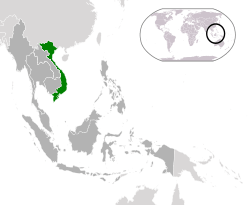 | |
| Capital | Hanoi 21°2′N 105°51′E |
| Largest city | Ho Chi Minh City 10°48′N 106°39′E |
| National language | Vietnamese[n 1] |
| Ethnic groups |
|
| Religion |
|
| Demonym(s) | Vietnamese |
| Government | Unitary Marxist–Leninist one-party socialist republic |
| Nguyễn Phú Trọng[n 3] | |
| Nguyễn Xuân Phúc | |
| Nguyễn Thị Kim Ngân | |
| Đặng Thị Ngọc Thịnh | |
| Trương Hòa Bình | |
| Legislature | National Assembly |
| Formation | |
| c. 2879 BC | |
| 204 BC | |
| 111 BC | |
| 1 February 939 | |
• Second reclaimed Independence from China | 29 April 1428 |
| 1 June 1802 | |
• Became under French Protectorate | 1887 |
| 2 September 1945 | |
• Geneva Accords | 21 July 1954 |
| 2 July 1976[4] | |
• Current constitution | 28 November 2013[n 4] |
| Area | |
• Total | 331,212 km2 (127,882 sq mi) (65th) |
• Water (%) | 6.38 |
| Population | |
• 2019 census | 96,208,984[3] (15th) |
• Density | 290.48/km2 (752.3/sq mi) (30th) |
| GDP (PPP) | 2019 estimate |
• Total | |
• Per capita | |
| GDP (nominal) | 2019 estimate |
• Total | |
• Per capita | |
| Gini (2014) | 37.6[7] medium |
| HDI (2018) | medium · 118th |
| Currency | đồng (₫) (VND) |
| Time zone | UTC+07:00 (Vietnam Standard Time) |
| Date format | dd/mm/yyyy |
| Driving side | right |
| Calling code | +84 |
| ISO 3166 code | VN |
| Internet TLD | .vn |
Archaeological excavations indicate that Vietnam was inhabited as early as the Paleolithic age. The ancient Vietnamese nation, which was centered on the Red River valley and nearby coastal areas, was annexed by the Han Dynasty in the 2nd century BC, which subsequently made Vietnam a division of Imperial China for over a millennium. The first independent monarchy emerged in the 10th century AD. This paved the way for successive imperial dynasties as the nation expanded geographically southward until the Indochina Peninsula was colonised by the French in the mid-19th century. Modern Vietnam was born upon the Proclamation of Independence from France in 1945. Following Vietnamese victory against the French in the First Indochina War, which ended in 1954, the nation was divided into two rival states: communist North and anti-communist South. Conflicts intensified in the Vietnam War, which saw extensive US intervention in support of South Vietnam and ended with North Vietnamese victory in 1975.
After North and South Vietnam were reunified as a communist state under a unitary socialist government in 1976, the country became economically and politically isolated until 1986, when the Communist Party initiated a series of economic and political reforms that facilitated Vietnamese integration into world politics and the global economy. As a result of the successful reforms, Vietnam has enjoyed a high GDP growth rate, consistently ranked among the fastest-growing countries in the world. It nevertheless faces challenges including poverty, corruption, inadequate social welfare and a poor human rights record, including increasing persecution of religious groups and human rights advocates and intensifying restrictions on civil liberties.[11] By 2010, Vietnam had established diplomatic relations with 178 countries. It is a member of such international organisations as the United Nations (UN), the Association of Southeast Asian Nations (ASEAN), the Asia-Pacific Economic Cooperation (APEC) forum, and the World Trade Organization (WTO).
Etymology
The name Việt Nam (Vietnamese pronunciation: [viə̀t naːm]) is a variation of Nam Việt (Chinese: 南越; pinyin: Nányuè; literally "Southern Việt"), a name that can be traced back to the Triệu dynasty of the 2nd century BC.[12] The word Việt originated as a shortened form of Bách Việt (Chinese: 百越; pinyin: Bǎiyuè), the name of a group of people then living in southern China and Vietnam.[13] The form "Vietnam" (越南) is first recorded in the 16th-century oracular poem Sấm Trạng Trình. The name has also been found on 12 steles carved in the 16th and 17th centuries, including one at Bao Lam Pagoda in Hải Phòng that dates to 1558.[14] In 1802, Nguyễn Phúc Ánh (who later became Emperor Gia Long) established the Nguyễn dynasty. In the second year of his rule, he asked the Jiaqing Emperor of the Qing dynasty to confer on him the title 'King of Nam Viet/Nanyue' (南越 in Chinese) after seizing power in Annam. The Emperor refused since the name was related to Zhao Tuo's Nanyue, which included the regions of Guangxi and Guangdong in southern China. The Qing Emperor, therefore, decided to call the area "Viet Nam" instead.[n 6][16] Between 1804 and 1813, the name Vietnam was used officially by Emperor Gia Long.[n 6] It was revived in the early 20th century in Phan Bội Châu's History of the Loss of Vietnam, and later by the Vietnamese Nationalist Party (VNQDĐ).[17] The country was usually called Annam until 1945, when the imperial government in Huế adopted Việt Nam.[18]
History
Part of a series on the |
||||||||||||||||||||||||
|---|---|---|---|---|---|---|---|---|---|---|---|---|---|---|---|---|---|---|---|---|---|---|---|---|
| History of Vietnam | ||||||||||||||||||||||||
 | ||||||||||||||||||||||||
|
||||||||||||||||||||||||
|
Dominated
|
||||||||||||||||||||||||
|
||||||||||||||||||||||||
|
||||||||||||||||||||||||
|
||||||||||||||||||||||||
| Timeline | ||||||||||||||||||||||||
|
| ||||||||||||||||||||||||
Prehistory
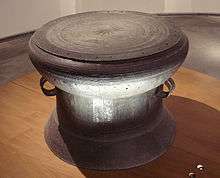
Archaeological excavations have revealed the existence of humans in what is now Vietnam as early as the Paleolithic age. Homo erectus fossils dating to around 500,000 BC have been found in caves in Lạng Sơn and Nghệ An provinces in northern Vietnam.[19] The oldest Homo sapiens fossils from mainland Southeast Asia are of Middle Pleistocene provenance, and include isolated tooth fragments from Tham Om and Hang Hum.[20][21][22] Teeth attributed to Homo sapiens from the Late Pleistocene have been found at Dong Can,[23] and from the Early Holocene at Mai Da Dieu,[24][25] Lang Gao[26][27] and Lang Cuom.[28] By about 1,000 BC, the development of wet-rice cultivation in the Ma River and Red River floodplains led to the flourishing of Đông Sơn culture,[29][30] notable for its bronze casting used to make elaborate bronze Đông Sơn drums.[31][32][33] At this point, the early Vietnamese kingdoms of Văn Lang and Âu Lạc appeared, and the culture's influence spread to other parts of Southeast Asia, including Maritime Southeast Asia, throughout the first millennium BC.[32][34]
Dynastic Vietnam
.gif)
The Hồng Bàng dynasty of the Hùng kings first established in 2879 BC is considered the first Vietnamese state in the History of Vietnam (then known as Xích Quỷ and later Văn Lang).[35][36] In 257 BC, the last Hùng king was defeated by Thục Phán. He consolidated the Lạc Việt and Âu Việt tribes to form the Âu Lạc, proclaiming himself An Dương Vương.[37] In 179 BC, a Chinese general named Zhao Tuo defeated An Dương Vương and consolidated Âu Lạc into Nanyue.[30] However, Nanyue was itself incorporated into the empire of the Chinese Han dynasty in 111 BC after the Han–Nanyue War.[16][38] For the next thousand years, what is now northern Vietnam remained mostly under Chinese rule.[39][40] Early independence movements, such as those of the Trưng Sisters and Lady Triệu,[41] were temporarily successful,[42] though the region gained a longer period of independence as Vạn Xuân under the Anterior Lý dynasty between AD 544 and 602.[43][44][45] By the early 10th century, Vietnam had gained autonomy, but not sovereignty, under the Khúc family.[46]
In AD 938, the Vietnamese lord Ngô Quyền defeated the forces of the Chinese Southern Han state at Bạch Đằng River and achieved full independence for Vietnam after a millennium of Chinese domination.[47][48][49] Renamed Đại Việt (Great Viet), the nation enjoyed a golden era under the Lý and Trần dynasties. During the rule of the Trần Dynasty, Đại Việt repelled three Mongol invasions.[50][51] Meanwhile, the Mahāyāna branch of Buddhism flourished and became the state religion.[49][52] Following the 1406–7 Ming–Hồ War, which overthrew the Hồ dynasty, Vietnamese independence was interrupted briefly by the Chinese Ming dynasty, but was restored by Lê Lợi, the founder of the Lê dynasty.[53] The Vietnamese dynasties reached their zenith in the Lê dynasty of the 15th century, especially during the reign of Emperor Lê Thánh Tông (1460–1497).[54][55] Between the 11th and 18th centuries, Vietnam expanded southward in a process known as nam tiến ("southward expansion"),[56] eventually conquering the kingdom of Champa and part of the Khmer Empire.[57][58][59]
From the 16th century onward, civil strife and frequent political infighting engulfed much of Vietnam. First, the Chinese-supported Mạc dynasty challenged the Lê dynasty's power.[60] After the Mạc dynasty was defeated, the Lê dynasty was nominally reinstalled. Actual power, however, was divided between the northern Trịnh lords and the southern Nguyễn lords, who engaged in a civil war for more than four decades before a truce was called in the 1670s.[61] During this period, the Nguyễn expanded southern Vietnam into the Mekong Delta, annexing the Central Highlands and the Khmer lands in the Mekong Delta.[57][59][62] The division of the country ended a century later when the Tây Sơn brothers established a new dynasty. However, their rule did not last long, and they were defeated by the remnants of the Nguyễn lords, led by Nguyễn Ánh, aided by the French.[63] Nguyễn Ánh unified Vietnam, and established the Nguyễn dynasty, ruling under the name Gia Long.[62]
French Indochina
.jpg)
In the 1500s, the Portuguese became acquainted with the Vietnamese coast, where they reportedly erected a stele on the Chàm Islands to mark their presence.[64] By 1533, they began landing in the Vietnamese delta but were forced to leave because of local turmoil and fighting. They also had less interest in the territory than they did in China and Japan.[64] After having successfully settled Macau and Nagasaki to begin the profitable Macau-Japan trade route, the Portuguese began to involve themselves in trade with Hội An, where many Portuguese traders and Catholic missionaries set foot in the Vietnamese kingdom.[64] The Dutch also tried to establish contact with Vietnam through the central part of Quinam in 1601 but failed to sustain a presence there after several violent encounters with the locals. The Dutch East India Company (VOC) only managed to establish official relations with Tonkin in the spring of 1637 after leaving Dejima in Japan to establish trade for silk.[65] Meanwhile, in 1613, the first British attempt to establish contact with Hội An failed following a violent incident involving the British East India Company. By 1672 the British managed to establish relations with Tonkin and were allowed to reside in Phố Hiến.[66]
Between 1615 and 1753, French traders also engaged in trade in the area around Đàng Trong and actively dispersed missionaries.[67][68] The Vietnamese kingdom began to feel threatened by continuous Christianisation activities.[69] Following the detention of several missionaries, the French Navy received approval from their government to intervene in Vietnam in 1834, with the aim of freeing imprisoned Catholic missionaries from a kingdom that was perceived as xenophobic.[70] Vietnam's sovereignty was gradually eroded by France, which was aided by the Spanish and large Catholic militias in a series of military conquests between 1859 and 1885.[71][72]
In 1862, the southern third of the country became the French colony of Cochinchina.[73] By 1884, the entire country had come under French rule, with the central and northern parts of Vietnam separated into the two protectorates of Annam and Tonkin. The three Vietnamese entities were formally integrated into the union of French Indochina in 1887.[74][75] The French administration imposed significant political and cultural changes on Vietnamese society.[76] A Western-style system of modern education was developed, and Catholicism was propagated widely.[77] Most French settlers in Indochina were concentrated in Cochinchina, particularly in Saigon, and in Hanoi, the colony's capital.[78]
.jpg)
Guerrillas of the royalist Cần Vương movement massacred around a third of Vietnam's Christian population during the colonial period as part of their rebellion against French rule.[79][80] They were defeated in the 1890s after a decade of resistance by the Catholics in reprisal for their earlier massacres.[81][82] Another large-scale rebellion, the Thái Nguyên uprising, was also suppressed heavily.[83] The French developed a plantation economy to promote the export of tobacco, indigo, tea and coffee.[84] However, they largely ignored the increasing demands for civil rights and self-government.
A nationalist political movement soon emerged, with leaders like Phan Bội Châu, Phan Châu Trinh, Phan Đình Phùng, Emperor Hàm Nghi, and Hồ Chí Minh fighting or calling for independence.[85] This resulted in the 1930 Yên Bái mutiny by the Vietnamese Nationalist Party (VNQDĐ), which the French quashed. The mutiny caused an irreparable split in the independence movement that resulted in many leading members of the organisation becoming communist converts.[86][87][88]
The French maintained full control over their colonies until World War II, when the war in the Pacific led to the Japanese invasion of French Indochina in 1940. Afterwards, the Japanese Empire was allowed to station its troops in Vietnam while permitting the pro-Vichy French colonial administration to continue.[89][90] Japan exploited Vietnam's natural resources to support its military campaigns, culminating in a full-scale takeover of the country in March 1945. This led to the Vietnamese Famine of 1945, which resulted in up to two million deaths.[91][92]
First Indochina War

In 1941, the Việt Minh, a nationalist liberation movement based on a Communist ideology, emerged under the Vietnamese revolutionary leader Hồ Chí Minh. The Việt Minh sought independence for Vietnam from France and the end of the Japanese occupation.[93][94] Following the military defeat of Japan and the fall of its puppet Empire of Vietnam in August 1945, anarchy, rioting, and murder were widespread, as Saigon's administrative services had collapsed.[95] The Việt Minh occupied Hanoi and proclaimed a provisional government, which asserted national independence on 2 September.[94]
Earlier, in July 1945, the Allies had decided to divide Indochina at the 16th parallel to allow Chiang Kai-shek of the Republic of China to receive the Japanese surrender in the north while Britain's Lord Louis Mountbatten received their surrender in the south. The Allies agreed that Indochina still belonged to France.[96][97]
However, as the French were weakened by the German occupation, British-Indian forces together with the remaining Japanese Southern Expeditionary Army Group were used to maintain order and to help France re-establish control through the 1945–1946 War in Vietnam.[98] Hồ Chí Minh initially chose to take a moderate stance to avoid military conflict with France. He asked the French to withdraw their colonial administrators, and for aid from French professors and engineers to help build a modern independent Vietnam.[94] However, the Provisional Government of the French Republic did not act on these requests, including the idea of independence, and dispatched the French Far East Expeditionary Corps to restore colonial rule. This resulted in the Việt Minh launching a guerrilla campaign against the French in late 1946.[93][94][99] The resulting First Indochina War lasted until July 1954. The defeat of French colonialists and Vietnamese loyalists in the 1954 battle of Điện Biên Phủ allowed Hồ Chí Minh to negotiate a ceasefire from a favourable position at the subsequent Geneva Conference.[94][100]
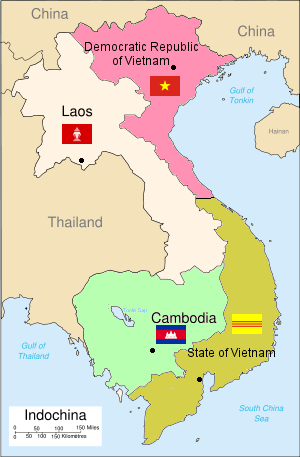
The colonial administration was therefore ended and French Indochina was dissolved under the Geneva Accords of 1954 into three countries—Vietnam, and the kingdoms of Cambodia and Laos. Vietnam was further divided into North and South administrative regions at the Demilitarised Zone, roughly along the 17th parallel north, pending elections scheduled for July 1956.[n 7] A 300-day period of free movement was permitted, during which almost a million northerners, mainly Catholics, moved south, fearing persecution by the communists. This migration was in large part aided by the United States military through Operation Passage to Freedom.[105][106] The partition of Vietnam by the Geneva Accords was not intended to be permanent, and stipulated that Vietnam would be reunited after elections in 1956.[107] However, in 1955, the southern State of Vietnam's prime minister, Ngô Đình Diệm, toppled Bảo Đại in a fraudulent referendum organised by his brother Ngô Đình Nhu, and proclaimed himself the president of the Republic of Vietnam.[107] At that point the internationally recognised State of Vietnam effectively ceased to exist and was replaced by the Republic of Vietnam in the south– supported by the United States, France, Laos, Republic of China and Thailand– and Hồ Chí Minh's Democratic Republic of Vietnam in the north– supported by the Soviet Union, Sweden,[108] Khmer Rouge, and the People's Republic of China.[107]
Vietnam War
Between 1953 and 1956, the North Vietnamese government instituted various agrarian reforms, including "rent reduction" and "land reform", which resulted in significant political repression.[109] During the land reform, testimony from North Vietnamese witnesses suggested a ratio of one execution for every 160 village residents, which extrapolated nationwide would indicate nearly 100,000 executions.[110] Because the campaign was concentrated mainly in the Red River Delta area, a lower estimate of 50,000 executions became widely accepted by scholars at the time.[110][111] However, declassified documents from the Vietnamese and Hungarian archives indicate that the number of executions was much lower than reported at the time, although likely greater than 13,500.[112] In the South, Diệm countered North Vietnamese subversion (including the assassination of over 450 South Vietnamese officials in 1956) by detaining tens of thousands of suspected communists in "political re-education centres".[113][114] This program incarcerated many non-communists, although it was also successful at curtailing communist activity in the country, if only for a time.[115] The North Vietnamese government claimed that 2,148 people were killed in the process by November 1957.[116] The pro-Hanoi Việt Cộng began a guerrilla campaign in South Vietnam in the late 1950s to overthrow Diệm's government.[117] From 1960, the Soviet Union and North Vietnam signed treaties providing for further Soviet military support.[118][119][120]
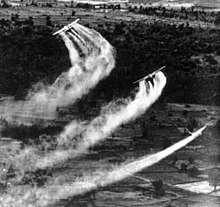
In 1963, Buddhist discontent with Diệm's Catholic regime erupted into mass demonstrations, leading to a violent government crackdown.[121] This led to the collapse of Diệm's relationship with the United States, and ultimately to a 1963 coup in which he and Nhu were assassinated.[122] The Diệm era was followed by more than a dozen successive military governments, before the pairing of Air Marshal Nguyễn Cao Kỳ and General Nguyễn Văn Thiệu took control in mid-1965.[123] Thiệu gradually outmaneuvered Kỳ and cemented his grip on power in fraudulent elections in 1967 and 1971.[124] During this political instability, the communists began to gain ground. To support South Vietnam's struggle against the communist insurgency, the United States began increasing its contribution of military advisers, using the 1964 Gulf of Tonkin incident as a pretext for such intervention.[125] US forces became involved in ground combat operations by 1965, and at their peak several years later, numbered more than 500,000.[126][127] The US also engaged in a sustained aerial bombing campaign. Meanwhile, China and the Soviet Union provided North Vietnam with significant materiel aid and 15,000 combat advisers.[118][119][128] Communist forces supplying the Việt Cộng carried supplies along the Hồ Chí Minh trail, which passed through the Kingdom of Laos.[129]
The communists attacked South Vietnamese targets during the 1968 Tết Offensive. Although the campaign failed militarily, it shocked the American establishment and turned US public opinion against the war.[130] During the offensive, communist troops massacred over 3,000 civilians at Huế.[131][132] A 1974 US Senate subcommittee estimated nearly 1.4 million Vietnamese civilians were killed or wounded between 1965 and 1974—over half the result of US and South Vietnamese military actions.[133] Facing an increasing casualty count, rising domestic opposition to the war, and growing international condemnation, the US began withdrawing from ground combat roles in the early 1970s. This process also entailed an unsuccessful effort to strengthen and stabilise South Vietnam.[134] Following the Paris Peace Accords of 27 January 1973, all American combat troops were withdrawn by 29 March 1973.[135] In December 1974, North Vietnam captured the province of Phước Long and started a full-scale offensive, culminating in the fall of Saigon on 30 April 1975.[136] South Vietnam was ruled by a provisional government for almost eight years while under military occupation by North Vietnam.[137]
Reunification and reforms
On 2 July 1976, North and South Vietnam were merged to form the Socialist Republic of Việt Nam.[138] The war left Vietnam devastated, with the total death toll between 966,000 and 3.8 million.[139][140][141] In the aftermath of the war, under Lê Duẩn's administration, there were no mass executions of South Vietnamese who had collaborated with the US or the defunct South Vietnamese government, confounding Western fears.[142] However, up to 300,000 South Vietnamese were sent to re-education camps, where many endured torture, starvation, and disease while being forced to perform hard labour.[143] The government embarked on a mass campaign of collectivisation of farms and factories.[144] In 1978, responding to the Khmer Rouge government of Cambodia, who had been invading and massacring Vietnamese residents in the border villages in the districts of An Giang and Kiên Giang,[145] the Vietnamese military invaded Cambodia and removed them from power after occupying Phnom Penh.[146] The intervention was a success, resulting in the establishment of a new pro-Vietnam socialist government, the People's Republic of Kampuchea, which ruled until 1989.[147] This action, however, worsened relations with China, which had supported the Khmer Rouge. China later launched a brief incursion into northern Vietnam in 1979, causing Vietnam to rely even more heavily on Soviet economic and military aid, while mistrust towards the Chinese government began to escalate.[148]
At the Sixth National Congress of the Communist Party of Vietnam (CPV) in December 1986, reformist politicians replaced the "old guard" government with new leadership.[149][150] The reformers were led by 71-year-old Nguyễn Văn Linh, who became the party's new general secretary.[149] Linh and the reformers implemented a series of free-market reforms known as Đổi Mới ("Renovation") which carefully managed the transition from a planned economy to a "socialist-oriented market economy".[151][152] Though the authority of the state remained unchallenged under Đổi Mới, the government encouraged private ownership of farms and factories, economic deregulation, and foreign investment, while maintaining control over strategic industries.[152][153] The Vietnamese economy subsequently achieved strong growth in agricultural and industrial production, construction, exports, and foreign investment, although these reforms also caused a rise in income inequality and gender disparities.[154][155][156]
Geography
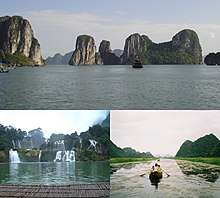
Vietnam is located on the eastern Indochinese Peninsula between the latitudes 8° and 24°N, and the longitudes 102° and 110°E. It covers a total area of approximately 331,212 km2 (127,882 sq mi).[n 8] The combined length of the country's land boundaries is 4,639 km (2,883 mi), and its coastline is 3,444 km (2,140 mi) long.[157] At its narrowest point in the central Quảng Bình Province, the country is as little as 50 kilometres (31 mi) across, though it widens to around 600 kilometres (370 mi) in the north.[158] Vietnam's land is mostly hilly and densely forested, with level land covering no more than 20%. Mountains account for 40% of the country's land area,[159] and tropical forests cover around 42%.[160] The Red River Delta in the north, a flat, roughly triangular region covering 15,000 km2 (5,792 sq mi),[161] is smaller but more intensely developed and more densely populated than the Mekong River Delta in the south. Once an inlet of the Gulf of Tonkin, it has been filled in over the millennia by riverine alluvial deposits.[162][163] The delta, covering about 40,000 km2 (15,444 sq mi), is a low-level plain no more than 3 metres (9.8 ft) above sea level at any point. It is criss-crossed by a maze of rivers and canals, which carry so much sediment that the delta advances 60 to 80 metres (196.9 to 262.5 ft) into the sea every year.[164][165] The exclusive economic zone of Vietnam covers 417,663 km2 (161,261 sq mi) in the South China Sea.[166]
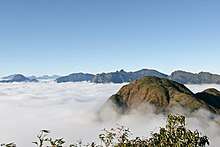
Southern Vietnam is divided into coastal lowlands, the mountains of the Annamite Range, and extensive forests. Comprising five relatively flat plateaus of basalt soil, the highlands account for 16% of the country's arable land and 22% of its total forested land.[167] The soil in much of the southern part of Vietnam is relatively low in nutrients as a result of intense cultivation.[168] Several minor earthquakes have been recorded in the past. Most have occurred near the northern Vietnamese border in the provinces of Điện Biên, Lào Cai and Sơn La, while some have been recorded offshore of the central part of the country.[169][170] The northern part of the country consists mostly of highlands and the Red River Delta. Fansipan (also known as Phan Xi Păng), which is located in Lào Cai Province, is the highest mountain in Vietnam, standing 3,143 m (10,312 ft) high.[171] From north to south Vietnam, the country also has numerous islands; Phú Quốc is the largest.[172] The Hang Sơn Đoòng Cave is considered the largest known cave passage in the world since its discovery in 2009. The Ba Bể Lake and Mekong River are the largest lake and longest river in the country.[173][174][175]
Climate
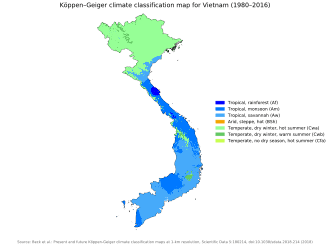
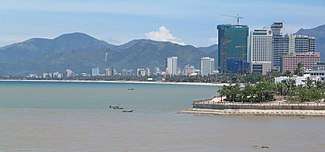
Due to differences in latitude and the marked variety in topographical relief, Vietnam's climate tends to vary considerably for each region.[176] During the winter or dry season, extending roughly from November to April, the monsoon winds usually blow from the northeast along the Chinese coast and across the Gulf of Tonkin, picking up considerable moisture.[177] The average annual temperature is generally higher in the plains than in the mountains, especially in southern Vietnam compared to the north. Temperatures vary less in the southern plains around Ho Chi Minh City and the Mekong Delta, ranging from between 21 and 35 °C (69.8 and 95.0 °F) over the year.[178] In Hanoi and the surrounding areas of Red River Delta, the temperatures are much lower between 15 and 33 °C (59.0 and 91.4 °F).[178] Seasonal variations in the mountains, plateaus, and the northernmost areas are much more dramatic, with temperatures varying from 3 °C (37.4 °F) in December and January to 37 °C (98.6 °F) in July and August.[179] Vietnam receives high rates of precipitation in the form of rainfall with an average amount from 1,500 mm (59 in) to 2,000 mm (79 in) during the monsoon seasons; this often causes flooding, especially in the cities with poor drainage systems.[180] The country is also affected by tropical depressions, tropical storms and typhoons.[180] Vietnam is one of the most vulnerable countries to climate change, with 55% of its population living in low-elevation coastal areas.[181][182]
Biodiversity
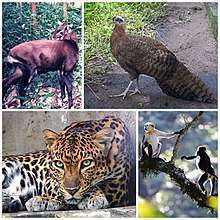
As the country is located within the Indomalayan realm, Vietnam is one of twenty-five countries considered to possess a uniquely high level of biodiversity. This was noted in the country's National Environmental Condition Report in 2005.[183] It is ranked 16th worldwide in biological diversity, being home to approximately 16% of the world's species. 15,986 species of flora have been identified in the country, of which 10% are endemic. Vietnam's fauna includes: 307 nematode species, 200 oligochaeta, 145 acarina, 113 springtails, 7,750 insects, 260 reptiles, and 120 amphibians. 840 birds and 310 mammals are found in Vietnam, of which 100 birds and 78 mammals are endemic.[183] Vietnam has two World Natural Heritage Sites, the Hạ Long Bay and Phong Nha-Kẻ Bàng National Park together with nine biosphere reserves including: Cần Giờ Mangrove Forest, Cát Tiên, Cát Bà, Kiên Giang, the Red River Delta, Mekong Delta, Western Nghệ An, Cà Mau and Cu Lao Cham Marine Park.[184][185][186]
.jpg)
Vietnam is also home to 1,438 species of freshwater microalgae, constituting 9.6% of all microalgae species, as well as 794 aquatic invertebrates and 2,458 species of sea fish.[183] In recent years, 13 genera, 222 species, and 30 taxa of flora have been newly described in Vietnam.[183] Six new mammal species, including the saola, giant muntjac and Tonkin snub-nosed monkey have also been discovered, along with one new bird species, the endangered Edwards's pheasant.[190] In the late 1980s, a small population of Javan rhinoceros was found in Cát Tiên National Park. However, the last individual of the species in Vietnam was reportedly shot in 2010.[191] In agricultural genetic diversity, Vietnam is one of the world's twelve original cultivar centres. The Vietnam National Cultivar Gene Bank preserves 12,300 cultivars of 115 species.[183] The Vietnamese government spent US$49.07 million on the preservation of biodiversity in 2004 alone and has established 126 conservation areas, including 30 national parks.[183]
Environment
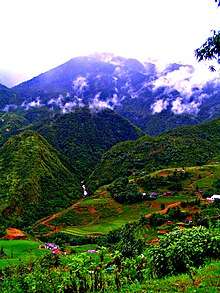
In Vietnam, wildlife poaching has become a major concern. In 2000, a non-governmental organisation (NGO) called Education for Nature – Vietnam was founded to instill in the population the importance of wildlife conservation in the country.[192] In the years that followed, another NGO called GreenViet was formed by Vietnamese youngsters for the enforcement of wildlife protection. Through collaboration between the NGOs and local authorities, many local poaching syndicates were crippled by their leaders' arrests.[192] A study released in 2018 revealed Vietnam is a destination for the illegal export of rhinoceros horns from South Africa due to the demand for them as a medicine and a status symbol.[193][194]
The main environmental concern that persists in Vietnam today is the legacy of the use of the chemical herbicide Agent Orange, which continues to cause birth defects and many health problems in the Vietnamese population. In the southern and central areas affected most by the chemical's use during the Vietnam War, nearly 4.8 million Vietnamese people have been exposed to it and suffered from its effects.[195][196][197] In 2012, approximately 50 years after the war,[198] the US began a US$43 million joint clean-up project in the former chemical storage areas in Vietnam to take place in stages.[196][199] Following the completion of the first phase in Đà Nẵng in late 2017,[200] the US announced its commitment to clean other sites, especially in the heavily impacted site of Biên Hòa, which is four times larger than the previously treated site, at an estimated cost of $390 million.[201]

The Vietnamese government spends over VNĐ10 trillion each year ($431.1 million) for monthly allowances and the physical rehabilitation of victims of the chemicals.[202] In 2018, the Japanese engineering group Shimizu Corporation, working with Vietnamese military, built a plant for the treatment of soil polluted by Agent Orange. Plant construction costs were funded by the company itself.[203][204] One of the long-term plans to restore southern Vietnam's damaged ecosystems is through the use of reforestation efforts. The Vietnamese government began doing this at the end of the war. It started by replanting mangrove forests in the Mekong Delta regions and in Cần Giờ outside Hồ Chí Minh City, where mangroves are important to ease (though not eliminate) flood conditions during monsoon seasons.[205]
Apart from herbicide problems, arsenic in the ground water in the Mekong and Red River Deltas has also become a major concern. [206][207] And most notoriously, unexploded ordnances (UXO) pose dangers to humans and wildlife—another bitter legacy from the long wars.[208] As part of the continuous campaign to demine/remove UXOs, several international bomb removal agencies from the United Kingdom,[209] Denmark,[210] South Korea[211] and the US[212] have been providing assistance. The Vietnam government spends over VNĐ1 trillion ($44 million) annually on demining operations and additional hundreds of billions of đồng for treatment, assistance, rehabilitation, vocational training and resettlement of the victims of UXOs.[213] In 2017 the Chinese government also removed 53,000 land mines and explosives left over from the war between the two countries, in an area of 18.4 km2 (7.1 sq mi) in the Chinese province of Yunnan bordering the China–Vietnam border.[214]
Government and politics

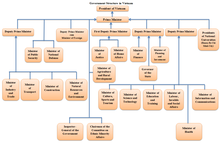
Vietnam is a unitary Marxist-Leninist one-party socialist republic, one of the two communist states (the other being Laos) in Southeast Asia.[215] Although Vietnam remains officially committed to socialism as its defining creed, its economic policies have grown increasingly capitalist,[216][217] with The Economist characterising its leadership as "ardently capitalist communists".[218] Under the constitution, the Communist Party of Vietnam (CPV) asserts their role in all branches of the country's politics and society.[215] The president is the elected head of state and the commander-in-chief of the military, serving as the chairman of the Council of Supreme Defence and Security, and holds the second highest office in Vietnam as well as performing executive functions and state appointments and setting policy.[215]
The general secretary of the CPV performs numerous key administrative functions, controlling the party's national organisation.[215] The prime minister is the head of government, presiding over a council of ministers composed of five deputy prime ministers and the heads of 26 ministries and commissions. Only political organisations affiliated with or endorsed by the CPV are permitted to contest elections in Vietnam. These include the Vietnamese Fatherland Front and worker and trade unionist parties.[215]
The National Assembly of Vietnam is the unicameral state legislature composed of 498 members.[219] Headed by a chairman, it is superior to both the executive and judicial branches, with all government ministers being appointed from members of the National Assembly.[215] The Supreme People's Court of Vietnam, headed by a chief justice, is the country's highest court of appeal, though it is also answerable to the National Assembly. Beneath the Supreme People's Court stand the provincial municipal courts and many local courts. Military courts possess special jurisdiction in matters of national security. Vietnam maintains the death penalty for numerous offences.[220]
Foreign relations
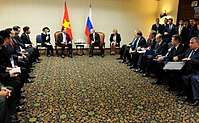
.jpg)
Throughout its history, Vietnam's main foreign relationship has been with various Chinese dynasties.[221] Following the partition of Vietnam in 1954, North Vietnam maintained relations with the Eastern Bloc, South Vietnam maintained relations with the Western Bloc.[221] Despite these differences, Vietnam's sovereign principles and insistence on cultural independence have been laid down in numerous documents over the centuries before its independence. These include the 11th-century patriotic poem "Nam quốc sơn hà" and the 1428 proclamation of independence "Bình Ngô đại cáo". Though China and Vietnam are now formally at peace,[221] significant territorial tensions remain between the two countries over the South China Sea.[222] Vietnam holds membership in 63 international organisations, including the United Nations (UN), Association of Southeast Asian Nations (ASEAN), Non-Aligned Movement (NAM), International Organisation of the Francophonie (La Francophonie), and World Trade Organization (WTO). It also maintains relations with over 650 non-governmental organisations.[223] As of 2010 Vietnam had established diplomatic relations with 178 countries.[224]
Vietnam's current foreign policy is to consistently implement a policy of independence, self-reliance, peace, co-operation, and development, as well openness and diversification/multilateralisation with international relations.[225][226] The country declares itself a friend and partner of all countries in the international community, regardless of their political affiliation, by actively taking part in international and regional cooperative development projects.[152][225] Since the 1990s, Vietnam has taken several key steps to restore diplomatic ties with Western countries.[227] Relations with the United States began improving in August 1995 with both nations upgrading their liaison offices to embassy status.[228] As diplomatic ties between the two nations grew, the United States opened a consulate general in Ho Chi Minh City while Vietnam opened its consulate in San Francisco. Full diplomatic relations were also restored with New Zealand, which opened its embassy in Hanoi in 1995;[229] Vietnam established an embassy in Wellington in 2003.[230] Pakistan also reopened its embassy in Hanoi in October 2000, with Vietnam reopening its embassy in Islamabad in December 2005 and trade office in Karachi in November 2005.[231][232] In May 2016, US President Barack Obama further normalised relations with Vietnam after he announced the lifting of an arms embargo on sales of lethal arms to Vietnam.[233]
Military
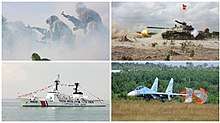
The Vietnam People's Armed Forces consists of the Vietnam People's Army (VPA), the Vietnam People's Public Security and the Vietnam Civil Defence Force. The VPA is the official name for the active military services of Vietnam, and is subdivided into the Vietnam People's Ground Forces, the Vietnam People's Navy, the Vietnam People's Air Force, the Vietnam Border Defence Force and the Vietnam Coast Guard. The VPA has an active manpower of around 450,000, but its total strength, including paramilitary forces, may be as high as 5,000,000.[234] In 2015, Vietnam's military expenditure totalled approximately US$4.4 billion, equivalent to around 8% of its total government spending.[235] Joint military exercises and war games have been held with Brunei,[236] India,[237] Japan,[238] Laos,[239] Russia,[240][241] Singapore[236] and the US.[242] In 2017, Vietnam signed the UN treaty on the Prohibition of Nuclear Weapons.[243][244]
Administrative divisions
Vietnam is divided into 58 provinces (Vietnamese: tỉnh, from the Chinese 省, shěng).[245] There are also five municipalities (thành phố trực thuộc trung ương), which are administratively on the same level as provinces.
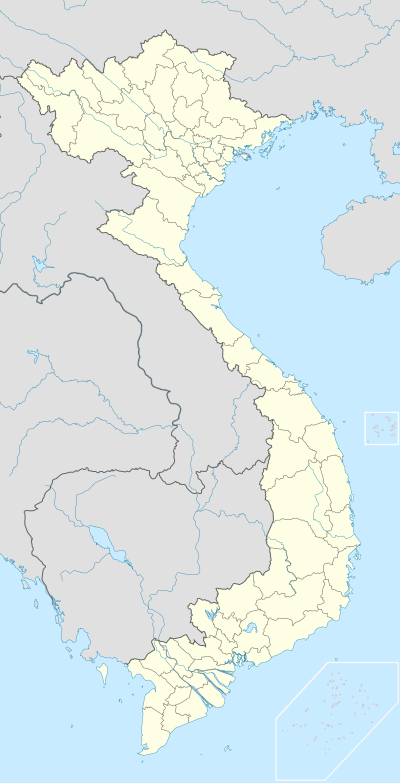 1
2
3
4
***
****
Provinces of Vietnam |
*-Phú Quốc Island **-Côn Đảo ***-Paracel Islands (Trường Sa, Khánh Hòa) |
|
Red River Delta
Bắc Ninh |
Bắc Giang |
|
Hà Tĩnh |
|
|
Bình Định |
Bà Rịa–Vũng Tàu |
An Giang |
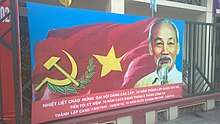
The provinces are subdivided into provincial municipalities (thành phố trực thuộc tỉnh), townships (thị xã) and counties (huyện), which are in turn subdivided into towns (thị trấn) or communes (xã). The centrally controlled municipalities are subdivided into districts (quận) and counties, which are further subdivided into wards (phường).
Human rights and sociopolitical issues
Under the current constitution, the CPV is the only party allowed to rule, the operation of all other political parties being outlawed. Other human rights issues concern freedom of association, freedom of speech, and freedom of the press. In 2009, Vietnamese lawyer Lê Công Định was arrested and charged with the capital crime of subversion; several of his associates were also arrested.[246][247] Amnesty International described him and his arrested associates as prisoners of conscience.[246]
Vietnam is predominantly a source country for trafficked persons who are exploited for labor.[248] A number of citizens, primarily women and girls, from all ethnic groups in Vietnam and foreigners have been victims of sex trafficking in Vietnam.[249][250]
Economy
| Share of world GDP (PPP)[6] | |
|---|---|
| Year | Share |
| 1980 | 0.18% |
| 1990 | 0.23% |
| 2000 | 0.32% |
| 2010 | 0.43% |
| 2018 | 0.52% |
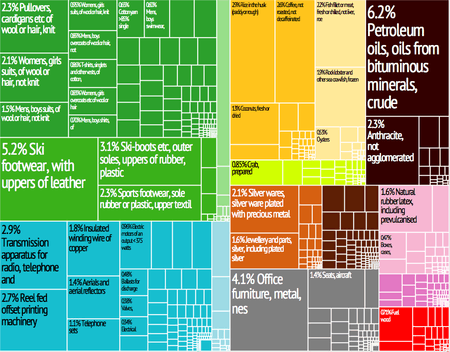
Throughout the history of Vietnam, its economy has been based largely on agriculture—primarily wet rice cultivation.[251] Bauxite, an important material in the production of aluminium, is mined in central Vietnam.[252] Since reunification, the country's economy is shaped primarily by the CPV through Five Year Plans decided upon at the plenary sessions of the Central Committee and national congresses.[253] The collectivisation of farms, factories, and capital goods was carried out as part of the establishment of central planning, with millions of people working for state enterprises. Under strict state control, Vietnam's economy continued to be plagued by inefficiency, corruption in state-owned enterprises, poor quality and underproduction.[254][255][256] With the decline in economic aid from its main trading partner, the Soviet Union, following the erosion of the Eastern bloc in the late 1980s, and the subsequent collapse of the Soviet Union, as well as the negative impacts of the post-war trade embargo imposed by the United States,[257][258] Vietnam began to liberalise its trade by devaluing its exchange rate to increase exports and embarked on a policy of economic development.[259]
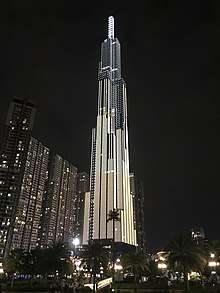
In 1986, the Sixth National Congress of the CPV introduced socialist-oriented market economic reforms as part of the Đổi Mới reform program. Private ownership began to be encouraged in industry, commerce and agriculture and state enterprises were restructured to operate under market constraints.[260][261] This led to the five-year economic plans being replaced by the socialist-oriented market mechanism.[262] As a result of these reforms, Vietnam achieved approximately 8% annual gross domestic product (GDP) growth between 1990 and 1997.[263][264] The United States ended its economic embargo against Vietnam in early 1994.[265] Despite the 1997 Asian financial crisis affecting Vietnam by causing an economic slowdown to 4–5% growth per annum, its economy began to recover in 1999,[260] with growth at an annual rate of around 7% from 2000 to 2005 making it one of the world's fastest growing economies.[266][267] According to the General Statistics Office of Vietnam (GSO), growth remained strong even in the face of the late-2000s global recession, holding at 6.8% in 2010, although Vietnam's year-on-year inflation rate hit 11.8% in December 2010 with the country's currency, the Vietnamese đồng being devalued three times.[268][269]

Deep poverty, defined as the percentage of the population living on less than $1 per day, has declined significantly in Vietnam and the relative poverty rate is now less than that of China, India and the Philippines.[270] This decline can be attributed to equitable economic policies aimed at improving living standards and preventing the rise of inequality.[271] These policies have included egalitarian land distribution during the initial stages of the Đổi Mới program, investment in poorer remote areas, and subsidising of education and healthcare.[272][273] Since the early 2000s, Vietnam has applied sequenced trade liberalisation, a two-track approach opening some sectors of the economy to international markets.[271][274] Manufacturing, information technology and high-tech industries now form a large and fast-growing part of the national economy. Though Vietnam is a relative newcomer to the oil industry, it is currently the third-largest oil producer in Southeast Asia with a total 2011 output of 318,000 barrels per day (50,600 m3/d).[275] In 2010, Vietnam was ranked as the eighth-largest crude petroleum producer in the Asia and Pacific region.[276] The United States purchased the highest amount of Vietnam's exports,[277] while goods from China were the most popular Vietnamese import.[278]
According to a December 2005 forecast by Goldman Sachs, the Vietnamese economy will become the world's 21st-largest by 2025,[279] with an estimated nominal GDP of $436 billion and a nominal GDP per capita of $4,357.[280] Based on findings by the International Monetary Fund (IMF) in 2012, the unemployment rate in Vietnam stood at 4.46%.[6] That same year, Vietnam's nominal GDP reached US$138 billion, with a nominal GDP per capita of $1,527.[6] The HSBC also predicted that Vietnam's total GDP would surpass those of Norway, Singapore and Portugal by 2050.[280][281] Another forecast by PricewaterhouseCoopers in 2008 stated Vietnam could be the fastest-growing of the world's emerging economies by 2025, with a potential growth rate of almost 10% per annum in real dollar terms.[282] Apart from the primary sector economy, tourism has contributed significantly to Vietnam's economic growth with 7.94 million foreign visitors recorded in 2015.[283]
Agriculture
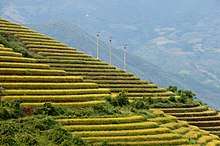
As a result of several land reform measures, Vietnam has become a major exporter of agricultural products. It is now the world's largest producer of cashew nuts, with a one-third global share;[284] the largest producer of black pepper, accounting for one-third of the world's market;[285] and the second-largest rice exporter in the world after Thailand since the 1990s.[286] Subsequently, Vietnam is also the world's second largest exporter of coffee.[287] The country has the highest proportion of land use for permanent crops together with other nations in the Greater Mekong Subregion.[288] Other primary exports include tea, rubber and fishery products. Agriculture's share of Vietnam's GDP has fallen in recent decades, declining from 42% in 1989 to 20% in 2006 as production in other sectors of the economy has risen.
Science and technology
In 2010, Vietnam's total state spending on science and technology amounted to roughly 0.45% of its GDP.[291] Since the dynastic era, Vietnamese scholars have developed many academic fields especially in social sciences and humanities. Vietnam has a millennium-deep legacy of analytical histories, such as the Đại Việt sử ký toàn thư of Ngô Sĩ Liên. Vietnamese monks, led by the abdicated Emperor Trần Nhân Tông, developed the Trúc Lâm Zen branch of philosophy in the 13th century.[292] Arithmetic and geometry have been widely taught in Vietnam since the 15th century, using the textbook Đại thành toán pháp by Lương Thế Vinh. Lương Thế Vinh introduced Vietnam to the notion of zero, while Mạc Hiển Tích used the term số ẩn (Eng: "unknown/secret/hidden number") to refer to negative numbers. Furthermore, Vietnamese scholars produced numerous encyclopaedias, such as Lê Quý Đôn's Vân đài loại ngữ.
In modern times, Vietnamese scientists have made many significant contributions in various fields of study, most notably in mathematics. Hoàng Tụy pioneered the applied mathematics field of global optimisation in the 20th century,[293] while Ngô Bảo Châu won the 2010 Fields Medal for his proof of fundamental lemma in the theory of automorphic forms.[294][295] Since the establishment of the Vietnam Academy of Science and Technology (VAST) by the government in 1975, the country is working to develop its first national space flight program especially after the completion of the infrastructure at the Vietnam Space Centre (VSC) in 2018.[296][297] Vietnam has also made significant advances in the development of robots, such as the TOPIO humanoid model.[289][290] One of Vietnam's main messaging apps, Zalo, was developed by Vương Quang Khải, a Vietnamese hacker who later worked with the country's largest information technology service company, the FPT Group.[298]

According to the UNESCO Institute for Statistics, Vietnam devoted 0.19% of its GDP to science research and development in 2011.[299] Between 2005 and 2014, the number of Vietnamese scientific publications recorded in Thomson Reuters' Web of Science increased at a rate well above the average for Southeast Asia, albeit from a modest starting point.[300] Publications focus mainly on life sciences (22%), physics (13%) and engineering (13%), which is consistent with recent advances in the production of diagnostic equipment and shipbuilding.[300] Almost 77% of all papers published between 2008 and 2014 had at least one international co-author. The autonomy which Vietnamese research centres have enjoyed since the mid-1990s has enabled many of them to operate as quasi-private organisations, providing services such as consulting and technology development.[300] Some have 'spun off' from the larger institutions to form their own semi-private enterprises, fostering the transfer of public sector science and technology personnel to these semi-private establishments. One comparatively new university, the Tôn Đức Thắng University which was built in 1997, has already set up 13 centres for technology transfer and services that together produce 15% of university revenue. Many of these research centres serve as valuable intermediaries bridging public research institutions, universities, and firms.[300]
Tourism
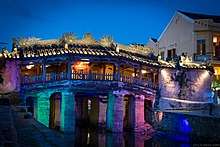
Tourism is an important element of economic activity in the country, contributing 7.5% of the gross domestic product. Vietnam welcomed over 12.9 million visitors in 2017, an increase of 29.1% over the previous year, making it one of the fastest growing tourist destinations in recent years. The vast majority of visitors in 2017, 9.7 million, came from Asia. China (4 million), South Korea (2.6 million) and Japan (798,119) made up half of all international arrivals in 2017.[301] Vietnam also attracts large numbers of visitors from Europe with almost 1.9 million visitors in 2017. Russia (574,164) and the United Kingdom (283,537), followed closely by France (255,396) and Germany (199,872) were the largest source of international arrivals from Europe. Other significant international arrivals by nationality include the United States (614,117) and Australia (370,438).[301]
The most visited destinations in Vietnam are Ho Chi Minh City with 5.8 million international arrivals, followed by Hanoi with 4.6 million and Hạ Long, including Hạ Long Bay with 4.4 million arrivals. All three are ranked in the top 100 most visited cities in the world.[302] Vietnam is home to eight UNESCO World Heritage Sites in Southeast Asia. In 2018, Travel + Leisure ranked Hội An as one of the world's top 15 best destinations to visit.[303]
Infrastructure
Transport
Much of Vietnam's modern transportation network can trace its roots to the French colonial era when it was used to facilitate the transportation of raw materials to its main ports. It was extensively expanded and modernised following the partition of Vietnam.[304] Vietnam's road system includes national roads administered at the central level, provincial roads managed at the provincial level, district roads managed at the district level, urban roads managed by cities and towns and commune roads managed at the commune level.[305] In 2010, Vietnam's road system had a total length of about 188,744 kilometres (117,280 mi) of which 93,535 kilometres (58,120 mi) are asphalt roads comprising national, provincial and district roads.[305] The length of the national road system is about 15,370 kilometres (9,550 mi) with 15,085 kilometres (9,373 mi) of its length paved. The provincial road system has around 27,976 kilometres (17,383 mi) of paved roads while 50,474 kilometres (31,363 mi) district roads are paved.[305]

Bicycles, motorcycles and motor scooters remain the most popular forms of road transport in the country, a legacy of the French, though the number of privately owned cars has been increasing in recent years.[306] Public buses operated by private companies are the main mode of long-distance travel for much of the population. Road accidents remain the major safety issue of Vietnamese transportation with an average of 30 people losing their lives daily.[307] Traffic congestion is a growing problem in both Hanoi and Ho Chi Minh City especially with the growth of individual car ownership.[308][309] Vietnam's primary cross-country rail service is the Reunification Express from Ho Chi Minh City to Hanoi, a distance of nearly 1,726 kilometres (1,072 mi).[310] From Hanoi, railway lines branch out to the northeast, north, and west; the eastbound line runs from Hanoi to Hạ Long Bay, the northbound line from Hanoi to Thái Nguyên, and the northeast line from Hanoi to Lào Cai. In 2009, Vietnam and Japan signed a deal to build a high-speed railway—shinkansen (bullet train)—using Japanese technology.[311] Vietnamese engineers were sent to Japan to receive training in the operation and maintenance of high-speed trains.[312] The planned railway will be a 1,545 kilometres (960 mi)-long express route serving a total of 23 stations, including Hanoi and Ho Chi Minh City, with 70% of its route running on bridges and through tunnels.[313][314] The trains will travel at a maximum speed of 350 kilometres (220 mi) per hour.[314][315] Plans for the high-speed rail line, however, have been postponed after the Vietnamese government decided to prioritise the development of both the Hanoi and Ho Chi Minh City metros and expand road networks instead.[310][316][317]
Vietnam operates 20 major civil airports, including three international gateways: Noi Bai in Hanoi, Da Nang International Airport in Đà Nẵng and Tan Son Nhat in Ho Chi Minh City. Tan Son Nhat is the nation's largest airport handling the majority of international passenger traffic.[318] According to a state-approved plan, Vietnam will have another seven international airports by 2025 including: Vinh International Airport, Phu Bai International Airport, Cam Ranh International Airport, Phu Quoc International Airport, Cat Bi International Airport, Can Tho International Airport, and Long Thanh International Airport. The planned Long Thanh International Airport will have an annual service capacity of 100 million passengers once it becomes fully operational in 2025.[319] Vietnam Airlines, the state-owned national airline, maintains a fleet of 86 passenger aircraft and aims to operate 170 by 2020.[320] Several private airlines also operate in Vietnam, including Air Mekong, Bamboo Airways, Jetstar Pacific Airlines, VASCO and VietJet Air. As a coastal country, Vietnam has many major sea ports, including: Cam Ranh, Đà Nẵng, Hải Phòng, Ho Chi Minh City, Hạ Long, Qui Nhơn, Vũng Tàu, Cửa Lò and Nha Trang. Further inland, the country's extensive network of rivers plays a key role in rural transportation with over 47,130 kilometres (29,290 mi) of navigable waterways carrying ferries, barges and water taxis.[321]
Energy
Vietnam's energy sector is dominated largely by the nationwide Vietnam Electricity Group (EVN). As of 2017, EVN made up about 61.4% of the country's power generation system with a total power capacity of 25,884 MW.[323] Other energy sources are PetroVietnam (4,435 MW), Vinacomin (1,785 MW) and 10,031 MW from build–operate–transfer (BOT) investors.[324]
Most of Vietnam's power is generated by either hydropower or fossil fuel power such as coal, oil and gas, while diesel, small hydropower and renewable energy supplies the remainder.[324] The Vietnamese government had planned to develop a nuclear reactor as the path to establish another source for electricity from nuclear power. The plan was abandoned in late 2016 when a majority of the National Assembly voted to oppose the project due to widespread public concern over radioactive contamination.[325]
The household gas sector in Vietnam is dominated by PetroVietnam, which controls nearly 70% of the country's domestic market for liquefied petroleum gas (LPG).[326] Since 2011, the company also operates five renewable energy power plants including the Nhơn Trạch 2 Thermal Power Plant (750 MW), Phú Quý Wind Power Plant (6 MW), Hủa Na Hydro-power Plant (180 MW), Dakdrinh Hydro-power Plant (125 MW) and Vũng Áng 1 Thermal Power Plant (1,200 MW).[327]
According to statistics from British Petroleum (BP), Vietnam is listed among the 52 countries that have proven crude oil reserves. In 2015 the reserve was approximately 4.4 billion barrels ranking Vietnam first place in Southeast Asia, while the proven gas reserves were about 0.6 trillion cubic meters (tcm) and ranking it third in Southeast Asia after Indonesia and Malaysia.[328]
Telecommunication
Telecommunications services in Vietnam are wholly provided by the Vietnam Post and Telecommunications General Corporation (now the VNPT Group) which is a state-owned company.[329] The VNPT retained its monopoly until 1986. The telecom sector was reformed in 1995 when the Vietnamese government began to implement a competitive policy with the creation of two domestic telecommunication companies, the Military Electronic and Telecommunication Company (Viettel, which is wholly owned by the Vietnamese Ministry of Defence) and the Saigon Post and Telecommunication Company (SPT or SaigonPostel), with 18% of it owned by VNPT.[329] VNPT's monopoly was finally ended by the government in 2003 with the issuance of a decree.[330] By 2012, the top three telecom operators in Vietnam were Viettel, Vinaphone and MobiFone. The remaining companies included: EVNTelecom, Vietnammobile and S-Fone.[331] With the shift towards a more market-orientated economy, Vietnam's telecommunications market is continuously being reformed to attract foreign investment, which includes the supply of services and the establishment of nationwide telecom infrastructure.[332]
Water supply and sanitation
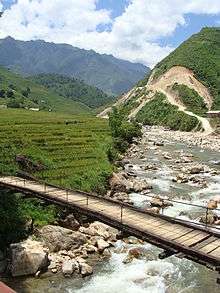
Vietnam has 2,360 rivers with an average annual discharge of 310 billion m³. The rainy season accounts for 70% of the year's discharge.[333] Most of the country's urban water supply systems have been developed without proper management within the last 10 years. Based on a 2008 survey by the Vietnam Water Supply and Sewerage Association (VWSA), existing water production capacity exceeded demand, but service coverage is still sparse. Most of the clean water supply infrastructure is not widely developed. It is only available to a small proportion of the population with about one third of 727 district towns having some form of piped water supply.[334] There is also concern over the safety of existing water resources for urban and rural water supply systems. Most industrial factories release their untreated wastewater directly into the water sources. Where the government does not take measures to address the issue, most domestic wastewater is discharged, untreated, back into the environment and pollutes the surface water.[334]
In recent years, there have been some efforts and collaboration between local and foreign universities to develop access to safe water in the country by introducing water filtration systems. There is a growing concern among local populations over the serious public health issues associated with water contamination caused by pollution as well as the high levels of arsenic in groundwater sources.[335] The government of Netherlands has been providing aid focusing its investments mainly on water-related sectors including water treatment projects.[336][337][338] Regarding sanitation, 78% of Vietnam's population has access to "improved" sanitation—94% of the urban population and 70% of the rural population. However, there are still about 21 million people in the country lacking access to "improved" sanitation according to a survey conducted in 2015.[339] In 2018, the construction ministry said the country's water supply, and drainage industry had been applying hi-tech methods and information technology (IT) to sanitation issues but faced problems like limited funding, climate change, and pollution.[340] The health ministry has also announced that water inspection units will be established nationwide beginning in June 2019. Inspections are to be conducted without notice since there have been many cases involving health issues caused by poor or polluted water supplies as well unhygienic conditions reported every year.[341]
Health
By 2015, 97% of the population had access to improved water sources.[342] In 2016, Vietnam's national life expectancy stood at 80.9 years for women and 71.5 for men, and the infant mortality rate was 17 per 1,000 live births.[7][343][344] Despite these improvements, malnutrition is still common in rural provinces.[156] Since the partition, North Vietnam has established a public health system that has reached down to the hamlet level.[345] After the national reunification in 1975, a nationwide health service was established.[156] In the late 1980s, the quality of healthcare declined to some degree as a result of budgetary constraints, a shift of responsibility to the provinces and the introduction of charges.[272] Inadequate funding has also contributed to a shortage of nurses, midwives and hospital beds; in 2000, Vietnam had only 24.7 hospital beds per 10,000 people before declining to 23.7 in 2005 as stated in the annual report of Vietnamese Health Ministry.[346] The controversial use of herbicides as a chemical weapon by the US military during the war left tangible, long-term impacts upon the Vietnamese people that persist in the country today.[347][348] For instance, it led to three million Vietnamese people suffering health problems, one million birth defects caused directly by exposure to the chemical and 24% of Vietnam's land being defoliated.[349]
Since the early 2000s, Vietnam has made significant progress in combating malaria. The malaria mortality rate fell to about five percent of its 1990s equivalent by 2005 after the country introduced improved antimalarial drugs and treatment.[350] Tuberculosis (TB) cases, however, are on the rise. TB has become the second most infectious disease in the country after respiratory-related illness.[351] With an intensified vaccination program, better hygiene and foreign assistance, Vietnam hopes to reduce sharply the number of TB cases and new TB infections.[352] In 2004, government subsidies covering about 15% of health care expenses.[353] That year, the United States announced Vietnam would be one of 15 nations to receive funding as part of its global AIDS relief plan.[354] By the following year, Vietnam had diagnosed 101,291 human immunodeficiency virus (HIV) cases, of which 16,528 progressed to acquired immune deficiency syndrome (AIDS); 9,554 have died.[355] The actual number of HIV-positive individuals is estimated to be much higher. On average between 40–50 new infections are reported daily in the country. In 2007, 0.4% of the population was estimated to be infected with HIV and the figure has remained stable since 2005.[356] More global aid is being delivered through The Global Fund to Fight AIDS, Tuberculosis and Malaria to fight the spread of the disease in the country.[352] In September 2018, the Hanoi People's Committee urged the citizens of the country to stop eating dog and cat meat as it can cause diseases like rabies and leptospirosis. More than 1,000 stores in the capital city of Hanoi were found to be selling both meats. The decision prompted positive comments among Vietnamese on social media, though some noted that the consumption of dog meat will remain an ingrained habit among many people.[357]
Education
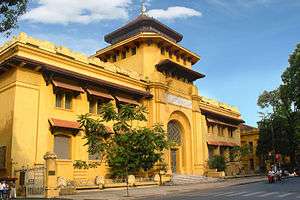
Vietnam has an extensive state-controlled network of schools, colleges, and universities and a growing number of privately run and partially privatised institutions. General education in Vietnam is divided into five categories: kindergarten, elementary schools, middle schools, high schools, and universities. A large number of public schools have been constructed across the country to raise the national literacy rate, which stood at 90% in 2008.[358] Most universities are located in major cities of Hanoi and Ho Chi Minh City with the country's education system continuously undergoing a series of reforms by the government. Basic education in the country is relatively free for the poor although some families may still have trouble paying tuition fees for their children without some form of public or private assistance.[359] Regardless, Vietnam's school enrolment is among the highest in the world.[360][361] The number of colleges and universities increased dramatically in the 2000s from 178 in 2000 to 299 in 2005. In higher education, the government provides subsidised loans for students through the national bank, although there are deep concerns about access to the loans as well the burden on students to repay them.[362][363]Since 1995, enrolment in higher education has grown tenfold to over 2.2 million with 84,000 lecturers and 419 institutions of higher education.[364] A number of foreign universities operate private campuses in Vietnam, including Harvard University (USA) and the Royal Melbourne Institute of Technology (Australia). The government's strong commitment to education has fostered significant growth but still need to be sustained to retain academics. In 2018, a decree on university autonomy allowing them to operate independently without ministerial control is in its final stages of approval. The government will continue investing in education especially for the poor to have access to basic education.[365]
Demographics

| Population[366] | |||
|---|---|---|---|
| Year | Million | ||
| 1950 | 24.8 | ||
| 2000 | 80.3 | ||
| 2018 | 95.5 | ||
As of 2018, the population of Vietnam stands at approximately 95.5 million people.[366] The population had grown significantly from the 1979 census, which showed the total population of reunified Vietnam to be 52.7 million.[367] According to the 2019 census, the country's population was 96,208,984.[3] Based on the 2019 census, 65.6% of the Vietnamese population are living in rural areas while only 34.4% live in urban areas. The average growth rate of the urban population has recently increased which is attributed mainly to migration and rapid urbanisation.[3] The dominant Viet or Kinh ethnic group constitute 82,085,826 people or 85.32% of the population.[3] Most of their population is concentrated in the country's alluvial deltas and coastal plains. As a majority ethnic group, the Kinh possess significant political and economic influence over the country.[368] Despite this, Vietnam is also home to 54 other ethnic minority groups, including the Hmong, Dao, Tày, Thai and Nùng.[369] Many ethnic minorities such as the Muong, who are closely related to the Kinh, dwell in the highlands which cover two-thirds of Vietnam's territory.[370]
Other uplanders in the north migrated from southern China between the 1300s and 1800s.[371] Since the partition of Vietnam, the population of the Central Highlands was almost exclusively Degar (including over 40 tribal groups); however, the South Vietnamese government at the time enacted a program of resettling Kinh in indigenous areas.[372][373] The Hoa (ethnic Chinese) and Khmer Krom people are mainly lowlanders.[368][371] Throughout Vietnam's history, many Chinese people, largely from South China, migrated to the country as administrators, merchants and even refugees.[374] Since the reunification in 1976 an increase of communist policies nationwide resulted in the nationalisation and confiscation of property especially from the Hoa in the south and the wealthy in cities. This led many of them to leave Vietnam.[375][376] Furthermore, with the deterioration of Sino-Vietnamese relations after the border invasion by Chinese government in 1979 many Vietnamese were wary of Chinese government's intentions. This indirectly caused more Hoa people in the north to leave the country.[374][377]
Urbanisation
.jpg)
The number of people who live in urbanised areas in 2019 is 33,122,548 people (with the urbanisation rate at 34.4%).[3] Since 1986, Vietnam's urbanisation rates have surged rapidly after the Vietnamese government implemented the Đổi Mới economic program, changing the system into a socialist one and liberalising property rights. As a result, Hanoi and Ho Chi Minh City (the two major cities in the Red River Delta and Southeast regions respectively) increased their share of the total urban population from 8.5% and 24.9% to 15.9% and 31% respectively.[378] The Vietnamese government, through its construction ministry, forecasts the country will have a 45% urbanisation rate by 2020 although it was confirmed to only be 34.4% according to the 2019 census.[3] Urbanisation is said to have a positive correlation with economic growth. Any country with higher urbanisation rates has a higher GDP growth rate.[379] Furthermore, the urbanisation movement in Vietnam is mainly between the rural areas and the country's Southeast region. Ho Chi Minh City has received a large number of migrants due mainly to better weather and economic opportunities.[380]

A study also shows that rural-to-urban area migrants have a higher standard of living than both non-migrants in rural areas and non-migrants in urban areas. This results in changes to economic structures. In 1985, agriculture made up 37.2% of Vietnam's GDP; in 2008, that number had declined to 18.5%.[381] In 1985, industry made up only 26.2% of Vietnam's GDP; by 2008, that number had increased to 43.2%. Urbanisation also helps to improve basic services which increase people's standards of living. Access to electricity grew from 14% of total households with electricity in 1993 to above 96% in 2009.[381] In terms of access to fresh water, data from 65 utility companies shows that only 12% of households in the area covered by them had access to the water network in 2002; by 2007, more than 70% of the population was connected. Though urbanisation has many benefits, it has some drawbacks since it creates more traffic, and air and water pollution.[381]
Many Vietnamese use mopeds for transportation since they are relatively cheap and easy to operate. Their large numbers have been known to cause traffic congestion and air pollution in Vietnam. In the capital city alone, the number of mopeds increased from 0.5 million in 2001 to 4.7 million in 2013.[381] With rapid development, factories have sprung up which indirectly pollute the air and water. An example is the 2016 Vietnam marine life disaster caused by the Formosa Ha Tinh Steel Company illegally discharging toxic industrial waste into the ocean. This killed many fish and destroyed marine habitats in Vietnamese waters resulting in major losses to the country's economy.[382] The government is intervening and attempting solutions to decrease air pollution by decreasing the number of motorcycles while increasing public transportation. It has introduced more regulations for waste handling by factories. Although the authorities also have schedules for collecting different types of waste, waste disposal is another problem caused by urbanisation. The amount of solid waste generated in urban areas of Vietnam has increased by more than 200% from 2003 to 2008. Industrial solid waste accounted for 181% of that increase. One of the government's efforts includes attempting to promote campaigns that encourage locals to sort household waste since waste sorting is still not practised by most of Vietnamese society.[383]
Religion
Religion in Vietnam (2014)[384]
Under Article 70 of the 1992 Constitution of Vietnam, all citizens enjoy freedom of belief and religion.[385] All religions are equal before the law and each place of worship is protected under Vietnamese state law. Religious beliefs cannot be misused to undermine state law and policies.[385][386] According to a 2007 survey 81% of Vietnamese people did not believe in a god.[387] Based on government findings in 2009, the number of religious people increased by 932,000.[388] The latest official statistics, presented by the Vietnamese government to the United Nations special rapporteur in 2014,[384] indicate the overall number of followers of recognised religions is about 24 million of a total population of almost 90 million.[384] Formally recognised religious communities include: 11 million Buddhists, 6.2 million Catholics, 1.4 million Protestants, 4.4 million Caodaisms followers, 1.3 million Hoahaoism Buddhists as well as 75,000 Muslims, 7,000 Baha'ís and 1,500 Hindus.[384]
Mahāyāna is the dominant branch of Buddhism among the Kinh majority who follow the religion, while Theravāda is practised in almost entirely by the Khmer minority. About 7% of the population is Christian—made up of six million Roman Catholics and one million Protestants.[384] Catholicism was introduced to Vietnam in the 16th century and was firmly established by Jesuits missionaries (mainly Portuguese and Italian) from nearby Portuguese Macau and Malacca, and from remnants of persecuted Japanese Catholics in the 17th centuries.[389] French missionaries (from the Paris Foreign Missions Society) aided by Spanish missionaries (Dominicans) from neighbouring Spanish East Indies towards Tonkin actively sought converts in the 18th, 19th and 20th centuries.[390][391][392] A significant number of Vietnamese people are also adherents of Caodaism, an indigenous folk religion, which has structured itself on the model of the Catholic Church together with another Buddhist section of Hoahaoism.[393] Protestantism was only recently spread by American and Canadian missionaries throughout the modern civil war,[394] where it was largely accepted among the highland Montagnards of South Vietnam.[395] The largest Protestant churches are the Southern Evangelical Church of Vietnam (SECV) and the Evangelical Church of Vietnam North (ECVN). Around 770,000 of the country's Protestants are members of ethnic minorities.[394] Although it is one of the country's minority religions, and has a briefer history than Catholicism, Protestantism is one of the country's fastest-growing religion, expanding at a rate of 600% in recent decades.[394][396] Several other minority faiths exist in Vietnam, these include: Bani, Sunni and non-denominational sections of Islam which is practised primarily among the ethnic Cham minority.[397] There are also a few Kinh adherents of Islam, other minority adherents of Baha'i, as well as Hindus among the Cham's.[398][399]
Languages
The national language of the country is Vietnamese (tiếng Việt), a tonal Austroasiatic language (Mon–Khmer), which is spoken by the majority of the population. In its early history, Vietnamese writing used Chinese characters (chữ Hán) before a different meaning set of Chinese characters known as chữ Nôm developed between the 7th–13th century.[400][401][402] The folk epic Truyện Kiều (The Tale of Kieu, originally known as Đoạn trường tân thanh) by Nguyễn Du was written in chữ Nôm.[403] Chữ Quốc ngữ, the Romanised Vietnamese alphabet, was developed in the 17th century by Jesuit missionaries such as Francisco de Pina and Alexandre de Rhodes by using the alphabets of the Romance languages, particularly the Portuguese alphabet, which later became widely used through Vietnamese institutions during the French colonial period.[400][404] Vietnam's minority groups speak a variety of languages, including: Tày, Mường, Cham, Khmer, Chinese, Nùng and Hmong. The Montagnard peoples of the Central Highlands also speak a number of distinct languages, some belonging to the Austroasiatic and others to the Malayo-Polynesian language families.[405] In recent years, a number of sign languages have developed in the major cities.

The French language, a legacy of colonial rule, is spoken by many educated Vietnamese as a second language, especially among the older generation and those educated in the former South Vietnam, where it was a principal language in administration, education and commerce. Vietnam remains a full member of the International Organisation of the Francophonie (La Francophonie) and education has revived some interest in the language.[406] Russian, and to a lesser extent German, Czech and Polish are known among some northern Vietnamese whose families had ties with the Eastern Bloc during the Cold War.[407] With improved relations with Western countries and recent reforms in Vietnamese administration, English has been increasingly used as a second language and the study of English is now obligatory in most schools either alongside or in place of French.[408][409] The popularity of Japanese and Korean has also grown as the country's ties with other East Asian nations have strengthened.[410][411][412]
Culture
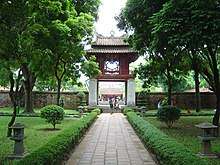
Vietnam's culture has developed over the centuries from indigenous ancient Đông Sơn culture with wet rice cultivation as its economic base.[29][32] Some elements of the nation's culture have Chinese origins, drawing on elements of Confucianism, Mahāyāna Buddhism and Taoism in its traditional political system and philosophy.[413][414] Vietnamese society is structured around làng (ancestral villages);[415] all Vietnamese mark a common ancestral anniversary on the tenth day of the third lunar month.[416][417] The influence of Chinese culture such as the Cantonese, Hakka, Hokkien and Hainanese cultures is more evident in the north where Buddhism is strongly entwined with popular culture.[418] Despite this, there is are Chinatowns in the south, such as in Chợ Lớn, where many Chinese have intermarried with Kinh and are indistinguishable among them.[419] In the central and southern parts of Vietnam, traces of Champa and Khmer culture are evidenced through the remains of ruins, artefacts as well within their population as the successor of the ancient Sa Huỳnh culture.[420][421] In recent centuries, Western cultures have become popular among recent generations of Vietnamese.[414]
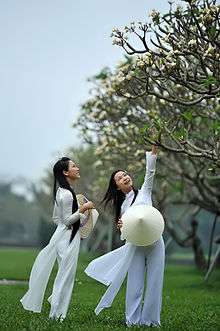
The traditional focuses of Vietnamese culture are based on humanity (nhân nghĩa) and harmony (hòa) in which family and community values are highly regarded.[418] Vietnam reveres a number of key cultural symbols,[422] such as the Vietnamese dragon which is derived from crocodile and snake imagery; Vietnam's national father, Lạc Long Quân is depicted as a holy dragon.[416][423][424] The lạc is a holy bird representing Vietnam's national mother Âu Cơ. Other prominent images that are also revered are the turtle, buffalo and horse.[425] Many Vietnamese also believe in the supernatural and spiritualism where illness can be brought on by a curse or sorcery or caused by non-observance of a religious ethic. Traditional medical practitioners, amulets and other forms of spiritual protection and religious practices may be employed to treat the ill person.[426] In the modern era, the cultural life of Vietnam has been deeply influenced by government-controlled media and cultural programs.[414] For many decades, foreign cultural influences, especially those of Western origin, were shunned. But since the recent reformation, Vietnam has seen a greater exposure to neighbouring Southeast Asian, East Asian as well to Western culture and media.[427]
The main Vietnamese formal dress, the áo dài is worn for special occasions such as weddings and religious festivals. White áo dài is the required uniform for girls in many high schools across the country. Other examples of traditional Vietnamese clothing include: the áo tứ thân, a four-piece woman's dress; the áo ngũ, a form of the thân in five-piece form, mostly worn in the north of the country; the yếm, a woman's undergarment; the áo bà ba, rural working "pyjamas" for men and women; the áo gấm, a formal brocade tunic for government receptions; and the áo the, a variant of the áo gấm worn by grooms at weddings.[428][429] Traditional headwear includes the standard conical nón lá and the "lampshade-like" nón quai thao.[429][430] In tourism, a number of popular cultural tourist destinations include the former Imperial City of Huế, the World Heritage Sites of Phong Nha-Kẻ Bàng National Park, Hội An and Mỹ Sơn, coastal regions such as Nha Trang, the caves of Hạ Long Bay and the Marble Mountains.[431][432]
Literature
.png)
Vietnamese literature has centuries-deep history and the country has a rich tradition of folk literature based on the typical six–to-eight-verse poetic form called ca dao which usually focuses on village ancestors and heroes.[433] Written literature has been found dating back to the 10th century Ngô dynasty, with notable ancient authors including: Nguyễn Trãi, Trần Hưng Đạo, Nguyễn Du and Nguyễn Đình Chiểu. Some literary genres play an important role in theatrical performance, such as hát nói in ca trù.[434] Some poetic unions have also been formed in Vietnam, such as the tao đàn. Vietnamese literature has been influenced by Western styles in recent times, with the first literary transformation movement of thơ mới emerging in 1932.[435] Vietnamese folk literature is an intermingling of many forms. It is not only an oral tradition, but a mixing of three media: hidden (only retained in the memory of folk authors), fixed (written), and shown (performed). Folk literature usually exists in many versions, passed down orally, and has unknown authors. Myths consist of stories about supernatural beings, heroes, creator gods and reflect the viewpoint of ancient people about human life.[436] They consist of creation stories, stories about their origins (Lạc Long Quân and Âu Cơ), culture heroes (Sơn Tinh and Thủy Tinh) which are referred to as a mountain and water spirit respectively and many other folklore tales.[419][437]
Music
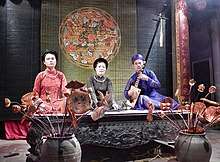
Traditional Vietnamese music varies between the country's northern and southern regions.[438] Northern classical music is Vietnam's oldest musical form and is traditionally more formal. The origins of Vietnamese classical music can be traced to the Mongol invasions in the 13th century when the Vietnamese captured a Chinese opera troupe.[439] Throughout its history, Vietnam has been the most heavily impacted by the Chinese musical tradition along with those of Japan, Korea and Mongolia.[440] Nhã nhạc is the most popular form of imperial court music, Chèo is a form of generally satirical musical theatre, while Xẩm or hát xẩm (xẩm singing) is a type of Vietnamese folk music. Quan họ (alternate singing) is popular in the former Hà Bắc Province (which is now divided into Bắc Ninh and Bắc Giang Provinces) and across Vietnam. Another form of music called Hát chầu văn or hát văn is used to invoke spirits during ceremonies. Nhạc dân tộc cải biên is a modern form of Vietnamese folk music which arose in the 1950s, while ca trù (also known as hát ả đào) is a popular folk music. Hò can be thought of as the southern style of Quan họ. There is a range of traditional instruments, including the đàn bầu (a monochord zither), the đàn gáo (a two-stringed fiddle with coconut body), and the đàn nguyệt (a two-stringed fretted moon lute). In recent times, there have been some efforts at mixing Vietnamese traditional music—especially folk music—with modern music to revive and promote national music in the modern context and educate the younger generations about Vietnam's traditional musical instruments and singing styles.[441]
Bolero music has gained popularity in the country since the 1930s, albeit with a different style—a combination of traditional Vietnamese music with Western elements.[442] However, the modern Vietnamese music industry, known as V-pop, is making its mark in the entertainment field. Many Vietnamese artists have started to collaborate with foreign artists and producers, especially South Korean, to facilitate the entrance of K-pop into the Vietnamese market while also promoting V-pop overseas.[443] For example, in 2014, the South Korean seven-member boy band BTS (방탄소년단) collaborated with Vietnamese singer Thanh Bùi on the single called "Danger".[443][444] In 2018, South Korean artist and idol Park Ji-yeon (박지연) collaborated with Soobin Hoàng Sơn on two versions of the title track called "Between Us" (Vietnamese: Đẹp Nhất Là Em; Korean: 우리사이) to promote the two countries’ partnership in terms of the music industry.[445] V Live, which is a South Korean live video streaming service, also collaborated with RBW Entertainment Vietnam (a subsidiary of the Korean entertainment company) to produce Vietnamese-based shows. V Live also launched special monthly mini-concerts called "V Heartbeat Live" to connect V-pop and K-pop idols.[446] South Korean entertainment company SM Entertainment signed an agreement with IPP Group to move into the country's market and promote joint business.[447] The company held its 2018 Global Audition in both Hanoi and Ho Chi Minh City in search for new talents among the Vietnamese youth.[448]
Cuisine
Traditionally, Vietnamese cuisine is based around five fundamental taste "elements" (Vietnamese: ngũ vị): spicy (metal), sour (wood), bitter (fire), salty (water) and sweet (earth).[449] Common ingredients include: fish sauce, shrimp paste, soy sauce, rice, fresh herbs, fruits and vegetables. Vietnamese recipes use: lemongrass, ginger, mint, Vietnamese mint, long coriander, Saigon cinnamon, bird's eye chilli, lime and basil leaves.[450] Traditional Vietnamese cooking is known for its fresh ingredients, minimal use of oil and reliance on herbs and vegetables; it is considered one of the healthiest cuisines worldwide.[451] The use of meats such as pork, beef and chicken was relatively limited in the past. Instead freshwater fish, crustaceans (particularly crabs), and molluscs became widely used. Fish sauce, soy sauce, prawn sauce and limes are among the main flavouring ingredients. Vietnam has a strong street food culture, with 40 popular dishes commonly found throughout the country.[452] Many notable Vietnamese dishes such as gỏi cuốn (salad roll), bánh cuốn (rice noodle roll), bún riêu (rice vermicelli soup) and phở noodles originated in the north and were introduced to central and southern Vietnam by northern migrants.[453][454] Local foods in the north are often less spicy than southern dishes, as the colder northern climate limits the production and availability of spices.[455] Black pepper is frequently used in place of chillis to produce spicy flavours. Vietnamese drinks in the south also are usually served cold with ice cubes, especially during the annual hot seasons; in contrast, in the north hot drinks are more preferable in a colder climate. Some examples of basic Vietnamese drinks include: cà phê đá (Vietnamese iced coffee), cà phê trứng (egg coffee), chanh muối (salted pickled lime juice), cơm rượu (glutinous rice wine), nước mía (sugarcane juice) and trà sen (Vietnamese lotus tea).[456]
Media

Vietnam's media sector is regulated by the government under the 2004 Law on Publication.[457] It is generally perceived that the country media sector is controlled by the government and follows the official communist party line, though some newspapers are relatively outspoken.[458][459] The Voice of Vietnam (VOV) is the official state-run national radio broadcasting service, broadcasting internationally via shortwave using rented transmitters in other countries and providing broadcasts from its website, while Vietnam Television (VTV) is the national television broadcasting company. Since 1997, Vietnam has regulated public internet access extensively using both legal and technical means. The resulting lockdown is widely referred to as the "Bamboo Firewall".[460] The collaborative project OpenNet Initiative classifies Vietnam's level of online political censorship to be "pervasive",[461] while Reporters Without Borders (RWB) considers Vietnam to be one of 15 global "internet enemies".[462] Though the government of Vietnam maintains that such censorship is necessary to safeguard the country against obscene or sexually explicit content, many political and religious websites that are deemed to be undermining state authority are also blocked.[463]
Holidays and festivals

The country has eleven national recognised holidays. These include: New Year's Day on 1 January; Vietnamese New Year (Tết) from the last day of the last lunar month to fifth day of the first lunar month; Hung Kings Commemorations on the 10th day of the third lunar month; Reunification Day on 30 April; International Workers' Day on 1 May; and National Day Celebration on 2 September.[464][465][466] During Tết, many Vietnamese from the major cities will return to their villages for family reunions and to pray for dead ancestors.[467][468] Older people will usually give the young a lì xì (red envelope) while special holiday food, such as bánh chưng (rice cake) in a square shape together with variety of dried fruits, are presented in the house for visitors.[469] Many other festivals are celebrated throughout the seasons, including the Lantern Festival (Tết Nguyên Tiêu), Mid-Autumn Festival (Tết Trung Thu) and various temple and nature festivals.[470] In the highlands, Elephant Race Festivals are held annually during the spring; riders will ride their elephants for about 1.6 km (0.99 mi) and the winning elephant will be given sugarcane.[471] Traditional Vietnamese weddings remain widely popular and are often celebrated by expatriate Vietnamese in Western countries.[472] In Vietnam, wedding dress has been influenced by Western styles, with the wearing of white wedding dresses and black jackets; however, there are also many who still prefer to choose Vietnamese traditional wedding costumes for traditional ceremonies.[473]
Sports
The Vovinam, kim ke and bình định martial arts are widespread in Vietnam,[474][475] while football is the country's most popular sport.[476] Its national team won the ASEAN Football Championship twice in 2008 and 2018 and reached the quarter-finals of 2019 AFC Asian Cup,[477][478][479] its junior team of under-23 became the runners-up of 2018 AFC U-23 Championship and reached fourth place in 2018 Asian Games, while the under-20 managed to qualify the 2017 FIFA U-20 World Cup for the first time in their football history.[480][481] The national football women's team also traditionally dominates the Southeast Asian Games, along with its chief rival, Thailand. Other Western sports such as badminton, tennis, volleyball, ping-pong and chess are also widely popular. Vietnam has participated in the Summer Olympic Games since 1952, when it competed as the State of Vietnam. After the partition of the country in 1954, only South Vietnam competed in the games, sending athletes to the 1956 and 1972 Olympics. Since the reunification of Vietnam in 1976, it has competed as the Socialist Republic of Vietnam, attending every Summer Olympics from 1988 onwards. The present Vietnam Olympic Committee was formed in 1976 and recognised by the International Olympic Committee (IOC) in 1979.[482] Vietnam has never participated in the Winter Olympic Games. In 2016, Vietnam won their first gold medal at the Olympics.[483] By the 2020s, Vietnam will host the inaugural Formula One Vietnam Grand Prix in the city of Hanoi.[484] Basketball has become an increasingly popular sport in Vietnam, especially in Ho Chi Minh City, Hanoi and Soc Trang.[485]
Notes
- The Constitution of the Socialist Republic of Vietnam states that Vietnamese is the "national language", rather than the "official language"; Vietnamese is the only language used in official documents and legal proceedings de facto.[1]
- Also called Kinh people.[2]
- Nguyễn Phú Trọng is also Secretary of the Central Military Commission of the Communist Party of Vietnam. The first priority political position in one party communist state, Vietnam is General Secretary of the Communist Party of Vietnam, not President of Vietnam.
- In effect since 1 January 2014.[5]
- The South China Sea is referred to in Vietnam as the East Sea (Biển Đông).[10]
- At first, Gia Long requested the name "Nam Việt", but the Jiaqing Emperor refused.[12][15]
- Neither the American government nor Ngô Đình Diệm's State of Vietnam signed anything at the 1954 Geneva Conference. The non-communist Vietnamese delegation objected strenuously to any division of Vietnam; however, the French accepted the Việt Minh proposal[101] that Vietnam be united by elections under the supervision of "local commissions".[102] The United States, with the support of South Vietnam and the United Kingdom, countered with the "American Plan",[103] which provided for United Nations-supervised unification elections. The plan, however, was rejected by Soviet and other communist delegations.[104]
- See List of countries and dependencies by area.
- The national symbol of Vietnam is officially recognised in the country's legal documents, including in the Constitution, which establishes the national flag, national emblem and national anthem. Although Vietnam is a country with many flowers, there is no document recognising its national flower. Other Association of Southeast Asian Nations (ASEAN) countries and all of Vietnam's neighbours have national flowers. The Lotus has been chosen by India as its national flower, but this does not preclude Vietnam making the same choice. Many countries have chosen the same flower as their national flower; for example, the rose is the national flower of Bulgaria, the Czech Republic and the United Kingdom).[189]
References
- "The Constitution of the Socialist Republic of Vietnam". Vietnam News Agency. 15 January 2014. Retrieved 13 June 2019.
- Communist Party of Vietnam 2004.
- "Report on Results of the 2019 Census". General Statistics Office of Vietnam. Retrieved 1 May 2020.
- Jeffries 2007, p. 4.
- Constitution of Vietnam 2014.
- International Monetary Fund.
- World Bank 2016a.
- "Human Development Report 2019" (PDF). United Nations Development Programme. 2019. Retrieved 9 December 2019.
- "About Vietnam".
- Cham 2012.
- "World Report 2019: Rights Trends in Vietnam". Human Rights Watch. 15 January 2019. Retrieved 12 May 2020.
- Woods 2002, p. 38.
- Yue Hashimoto 1972, p. 1.
- Phan 1976, p. 510.
- Shaofei & Guoqing 2016.
- Ooi 2004, p. 932.
- Tonnesson & Antlov 1996, p. 117.
- Tonnesson & Antlov 1996, p. 126.
- McKinney 2009.
- Akazawa, Aoki & Kimura 1992, p. 321.
- Rabett 2012, p. 109.
- Dennell & Porr 2014, p. 41.
- Matsumura et al. 2008, p. 12.
- Matsumura et al. 2001.
- Oxenham & Tayles 2006, p. 36.
- anon. 1985, p. 16.
- Karlström & Källén 2002, p. 83.
- Oxenham & Buckley 2015, p. 329.
- Higham 1984.
- Nang Chung & Giang Hai 2017, p. 31.
- de Laet & Herrmann 1996, p. 408.
- Calò 2009, p. 51.
- Kiernan 2017, p. 31.
- Cooke, Li & Anderson 2011, p. 46.
- Pelley 2002, p. 151.
- Cottrell 2009, p. 14.
- Đức Trần & Thư Hà 2000, p. 8.
- Yao 2016, p. 62.
- Holmgren 1980.
- Taylor 1983, p. 30.
- Pelley 2002, p. 177.
- Cottrell 2009, p. 15.
- Thái Nguyên & Mừng Nguyẽ̂n 1958, p. 33.
- Chesneaux 1966, p. 20.
- anon. 1972, p. 24.
- Tuyet Tran & Reid 2006, p. 32.
- Hiẻ̂n Lê 2003, p. 65.
- Hong Lien & Sharrock 2014, p. 55.
- Kiernan 2017, p. 226.
- Cottrell 2009, p. 16.
- Hong Lien & Sharrock 2014, p. 95.
- Keyes 1995, p. 183.
- Hong Lien & Sharrock 2014, p. 111.
- Hong Lien & Sharrock 2014, p. 120.
- Kiernan 2017, p. 265.
- Anderson & Whitmore 2014, p. 158.
- Vo 2011, p. 13.
- Ooi & Anh Tuan 2015, p. 212.
- Phuong Linh 2016, p. 39.
- Anderson & Whitmore 2014, p. 174.
- Leonard 1984, p. 131.
- Ooi 2004, p. 356.
- Page & Sonnenburg 2003, p. 723.
- Tuấn Hoáng 2007, p. 50.
- Tuấn Hoáng 2007, p. 52.
- Tuấn Hoáng 2007, p. 53.
- Li 1998, p. 89.
- Lockard 2010, p. 479.
- McLeod 1991, p. 22.
- Woods 2002, p. 245.
- Cortada 1994, p. 29.
- Keith 2012, p. 50.
- McLeod 1991, p. 61.
- Ooi 2004, p. 520.
- Cook 2001, p. 396.
- Frankum Jr. 2011, p. 172.
- Nhu Nguyen 2016, p. 37.
- Richardson 1876, p. 269.
- Keith 2012, p. 53.
- Anh Ngo 2016, p. 71.
- Quach Langlet 1991, p. 360.
- Ramsay 2008, p. 171.
- Zinoman 2000.
- Lim 2014, p. 33.
- Largo 2002, p. 112.
- Khánh Huỳnh 1986, p. 98.
- Odell & Castillo 2008, p. 82.
- Thomas 2012.
- Miller 1990, p. 293.
- Gettleman et al. 1995, p. 4.
- Thanh Niên 2015.
- Vietnam Net 2015.
- Joes 1992, p. 95.
- Pike 2011, p. 192.
- Gunn 2014, p. 270.
- Neville 2007, p. 175.
- Smith 2007, p. 6.
- Neville 2007, p. 124.
- Tonnesson 2011, p. 66.
- Waite 2012, p. 89.
- Gravel 1971, p. 134.
- Gravel 1971, p. 119.
- Gravel 1971, p. 140.
- Kort 2017, p. 96.
- Olson 2012, p. 43.
- DK 2017, p. 39.
- van Dijk et al. 2013, p. 68.
- Guttman, John (25 July 2013). "Why did Sweden support the Viet Cong?". History Net. Retrieved 25 September 2019.
- Moïse 2017, p. 56.
- Turner 1975, p. 143.
- Gittinger 1959.
- Vu 2007.
- Heneghan 1969, p. 160.
- Turner 1975, p. 177.
- Crozier 1955.
- Turner 1975, p. 174–178.
- Gilbert 2013, p. 292.
- Jukes 1973, p. 209.
- Olsen 2007, p. 92.
- Khoo 2011, p. 27.
- Muehlenbeck & Muehlenbeck 2012, p. 221.
- Willbanks 2013, p. 53.
- Duy Hinh & Dinh Tho 2015, p. 238.
- Isserman & Bowman 2009, p. 46.
- Alterman 2005, p. 213.
- Lewy 1980.
- Gibbons 2014, p. 166.
- Li 2012, p. 67.
- Gillet 2011.
- Dallek 2018.
- Turner 1975, p. 251.
- Frankum Jr. 2011, p. 209.
- Dohrenwend et al. 2018, p. 69.
- Eggleston 2014, p. 1.
- History 2018.
- Tucker 2011, p. 749.
- Brigham 1998, p. 86.
- The New York Times 1976.
- Hirschman, Preston & Manh Loi 1995.
- Shenon 1995.
- Obermeyer, Murray & Gakidou 2008.
- Elliott 2010, p. 499, 512–513.
- Sagan & Denny 1982.
- Spokesman-Review 1977, p. 8.
- Kissi 2006, p. 144.
- Meggle 2004, p. 166.
- Hampson 1996, p. 175.
- Khoo 2011, p. 131.
- BBC News 1997.
- Văn Phúc 2014.
- Murray 1997, p. 24–25.
- Bich Loan 2007.
- Howe 2016, p. 20.
- Goodkind 1995.
- Gallup 2002.
- Wagstaff, van Doorslaer & Watanabe 2003.
- Nasuchon 2008, p. 7.
- Protected Areas and Development Partnership 2003, p. 13.
- Fröhlich et al. 2013, p. 5.
- Natural Resources and Environment Program 1995, p. 56.
- Vietnam Ministry of Agriculture and Rural Development 2007.
- Huu Chiem 1993, p. 180.
- Minh Hoang et al. 2016.
- Huu Chiem 1993, p. 183.
- Hong Truong, Ye & Stive 2017, p. 757.
- Vietnamese Waters Zone.
- Cosslett & Cosslett 2017, p. 13.
- Van De et al. 2008.
- Hong Phuong 2012, p. 3.
- Việt Nam News 2016.
- Vietnam Ministry of Culture, Sports and Tourism 2014.
- Boobbyer & Spooner 2013, p. 173.
- Cosslett & Cosslett 2013, p. 13.
- Anh 2016a.
- The Telegraph.
- Lap Vu 1979, p. 66.
- Riehl & Augstein 1973, p. 1.
- Buleen 2017.
- Vietnam Net 2018a.
- Thi Anh.
- Overland 2017.
- "Report: Flooded Future: Global vulnerability to sea level rise worse than previously understood". climatecentral.org. 29 October 2019. Retrieved 3 November 2019.
- Vietnam National Environment Administration.
- UNESCO World Heritage Convention 1994.
- UNESCO World Heritage Convention 2003.
- Pha Le 2016.
- Nhân Dân 2011.
- Hinchey 2017, p. 30.
- Mạnh Cường & Ngọc Lin 2010.
- BirdLife International 2016.
- Kinver 2011.
- Dall 2017.
- Dang Vu & Nielsen 2018.
- Nam Dang & Nielsen 2019.
- Banout et al. 2014.
- Cerre 2016.
- Brown 2018.
- Agence France-Presse 2016.
- MacLeod 2012.
- United States Agency for International Development.
- Stewart 2018.
- Việt Nam News 2018a.
- Nikkei Asian Review 2018.
- NHK World-Japan 2018.
- Agent Orange Record.
- Berg et al. 2007.
- Merola et al. 2014.
- Miguel & Roland 2005.
- United Kingdom Department for International Development 2017.
- LM Report 2000.
- United Nations Development Programme 2018.
- United States Department of State 2006.
- Van Thanh 2016.
- Tao 2017.
- Government of Vietnam (II).
- Greenfield 1994, p. 204.
- Baccini, Impullitti & Malesky 2017.
- The Economist 2008.
- Embassy of Vietnam in USA.
- Vietnam Penal Code 1999.
- Thayer 1994.
- Thanh Hai 2016, p. 177.
- Vietnam Ministry of Foreign Affairs 2018.
- Vietnam Ministry of Foreign Affairs 2013.
- Vietnam Ministry of Foreign Affairs 2007.
- Vietnam Ministry of Foreign Affairs 2014.
- Dayley 2018, p. 98.
- Mitchell 1995.
- Green 2012.
- Smith 2005, p. 386.
- Institute of Regional Studies 2001, p. 66.
- Vietnam Ministry of Foreign Affairs.
- Garamone 2016.
- Taylor & Rutherford 2011, p. 50.
- Yan 2016.
- Voice of Vietnam 2016.
- The Economic Times 2018.
- The Japan Times 2015.
- Voice of Vietnam 2018b.
- Sputnik News 2015.
- Russia Ministry of Defence 2018.
- The Telegraph 2012.
- United Nations Treaty Collection.
- Giap 2017.
- Japan Ministry of Land, Infrastructure, Transport and Tourism.
- BBC News 2009.
- Mydans 2009.
- "VIET NAM – UN ACT". UN-Act.
- "Women, children and babies: human trafficking to China is on the rise". Asia News. 11 July 2019.
- "Vietnam's Human Trafficking Problem Is Too Big to Ignore". The Diplomat. 8 November 2019.
- Cornell University.
- Kim Phuong 2014, p. 1.
- Kimura 1986.
- Adhikari, Kirkpatrick & Weiss 1992, p. 249.
- Ngoc Vo & Le 2014, p. 7.
- Van Tho 2003, p. 11.
- Litvack, Litvack & Rondinelli 1999, p. 31.
- Freeman 2002.
- Litvack, Litvack & Rondinelli 1999, p. 33.
- Van Tho 2003, p. 5.
- Hoang Vuong & Dung Tran 2009.
- Hoang Vuong 2014.
- Largo 2002, p. 66.
- International Monetary Fund 1999, p. 23.
- Cockburn 1994.
- Pincus 2015, p. 27; this article refers to the so-called "Vent for surplus" theory of international trade.
- Quang Vinh, p. 13.
- Asian Development Bank 2010, p. 388.
- Thanh Niên 2010.
- Vierra & Vierra 2011, p. 5.
- Vandemoortele & Bird 2010.
- Cuong Le et al. 2010, p. 23.
- H. Dang & Glewwe 2017, p. 9.
- Vandemoortele 2010.
- UPI.com 2013.
- Fong-Sam 2010, p. 26.
- Việt Nam News 2018b.
- Vietnam News Agency 2018.
- Karmel 2010, p. 1.
- Lyimo 2016.
- Tuổi Trẻ News 2012.
- PWC 2008.
- Vietnam Net 2016a.
- Mai 2017.
- Voice of Vietnam 2018c.
- Nielsen 2007, p. 1.
- Summers 2014.
- Truong, Vo & Nguyen 2018, p. 172.
- DigInfo 2007.
- Borel 2010.
- Việt Nam News 2010.
- Różycka-Tran & Anh Tran 2014, p. 123.
- Koblitz 2009, p. 198.
- CNRS 2010.
- Koppes 2010.
- Vietnam National Space Centre 2016.
- Vietnam Academy of Science and Technology 2017.
- Raslan 2017.
- UNESCO Media Services 2016.
- UNESCO Publishing, p. 713–714.
- Vietnam General Statistics Office 2018.
- Quy 2018.
- Terzian 2018.
- Crook 2014, p. 7.
- Vietnam General Statistics Office 2010.
- Huu Duc et al. 2013, p. 2080.
- Vietnam General Statistics Office 2011.
- Linh Le & Anh Trinh 2016.
- Sohr et al. 2016, p. 220.
- Chin 2018.
- The Japan Times 2009.
- Vietnam+ 2008.
- The Nation 2018.
- Vietnam Net 2018b.
- South East Asia Iron and Steel Institute 2009.
- Chi 2017.
- Tatarski 2017.
- Hoang 2016, p. 1.
- Vietnam Investment Review 2018.
- Ha, Giang & Denslow 2012.
- Index Mundi 2018.
- Intellasia 2010.
- Electricity of Vietnam 2017, p. 10.
- Electricity of Vietnam 2017, p. 12.
- Nguyen et al. 2016.
- Nikkei Asian Review.
- Viet Trung, Quoc Viet & Van Chat 2016, p. 70.
- Viet Trung, Quoc Viet & Van Chat 2016, p. 64.
- Pham 2015, p. 6.
- Pham 2015, p. 7.
- Việt Nam News 2012.
- Oxford Business Group 2017.
- United Kingdom Department for International Trade 2017, p. 1.
- United Kingdom Department for International Trade 2017, p. 2.
- University of Technology Sydney 2018.
- Government of the Netherlands 2016.
- Government of the Netherlands 2018.
- Anh 2018.
- UNICEF 2015.
- Việt Nam News 2018c.
- Việt Nam News 2018d.
- Index Mundi 2016.
- World Bank 2016b.
- World Bank 2017.
- The Harvard Crimson 1972.
- Trung Chien 2006, p. 65.
- BBC News 2005.
- Haberman 2014.
- Gustafsson 2010, p. 125.
- Van Nam et al. 2005.
- Trinh et al. 2016.
- McNeil Jr. 2016.
- Lieberman & Wagstaff 2009, p. 40.
- Manyin 2005, p. 4.
- Vietnam Women's Union 2005.
- World Bank 2018a.
- BBC News 2018.
- UNICEF.
- Ha Trân 2014.
- World Bank 2013.
- World Bank 2015.
- Pham 2012.
- Chapman & Liu 2013.
- de Mora & Wood 2014, p. 55.
- Vietnam Net 2016b.
- United Nations Department of Economic and Social Affairs.
- Fraser 1980.
- Jones 1998, p. 21.
- Canada Ministry of Citizenship and Immigration 2013, p. 1.
- Government of Vietnam (I).
- Koskoff 2008, p. 1316.
- Cultural Orientation Resource Centre, p. 7.
- Montagnard Human Rights Organisation.
- Dodd & Lewis 2003, p. 531.
- Amer 1996.
- Feinberg 2016.
- Gough 1986.
- Vietnam General Statistics Office 2009b, p. 117.
- World Bank 2002.
- Vietnam General Statistics Office 2009b, p. 102.
- Cira et al. 2011, p. 194.
- Tiezzi 2016.
- Trương 2018, p. 19.
- Bielefeldt 2014.
- Constitution of Vietnam 1992.
- Vietnam Ordinance of Beliefs and Religion 2004.
- Zuckerman 2007, p. 11.
- Vietnam General Statistics Office 2009a.
- Tran, Anh Q. (October 2018). "The Historiography of the Jesuits in Vietnam: 1615–1773 and 1957–2007". Brill.
- Woods 2002, p. 34.
- Keith 2012, p. 42, 72.
- Lamport 2018, p. 898.
- Largo 2002, p. 168.
- Van Hoang 2017, p. 1.
- Cultural Orientation Resource Centre, p. 5, 7.
- United States Department of State 2005.
- Kỳ Phương & Lockhart 2011, p. 35.
- Levinson & Christensen 2002, p. 89.
- Sharma 2009, p. 48.
- Zwartjes 2011, p. 292.
- Choy 2013, p. 340.
- Dinh Tham 2018, p. 67.
- Ozolinš 2016, p. 130.
- Jacques 1998, p. 21.
- Cultural Orientation Resource Centre, p. 10.
- French Senate 1997.
- Van Van, p. 8.
- Van Van, p. 9.
- United Kingdom Department for International Trade 2018.
- Wai-ming 2002, p. 3.
- Anh Dinh 2016, p. 63.
- Hirano 2016.
- Tung Hieu 2015, p. 71.
- Nhu Nguyen 2016, p. 32.
- Endres 2001.
- Grigoreva 2014, p. 4.
- UNESCO Intangible Cultural Heritage 2012.
- Zhu et al. 2017, p. 142.
- McLeod & Thi Dieu 2001, p. 8.
- Momoki 1996, p. 36.
- Kỳ Phương & Lockhart 2011, p. 84.
- Vo 2012, p. 96.
- Gallop 2017.
- Vietnamese-American Association.
- Chonchirdsin 2016.
- Waitemata District Health Board 2015, p. 2.
- Phuong 2012.
- Lewandowski 2011, p. 12.
- Howard 2016, p. 90.
- Chico 2013, p. 354.
- Pha Le 2014.
- Vietnam Net 2017a.
- Huong 2010.
- Norton 2015.
- Le 2008.
- Vo 2012, p. 4.
- Tran & Le 2017, p. 5.
- van Khè 1972.
- Miettinen 1992, p. 163.
- Van Khê 1985.
- Voice of Vietnam 2018d.
- Duy 2016.
- Chen 2018, p. 194.
- Yan News 2014.
- Phương 2018.
- Quốc Hoàng 2018.
- SM Entertainment Group 2018.
- Dam-young 2018.
- Vietnam Culture Information Network 2014.
- Australia Special Broadcasting Service 2013.
- Corapi 2010.
- Clark & Miller 2017.
- Nguyen 2011.
- Thaker & Barton 2012, p. 170.
- Williams 2017.
- Batruny 2014.
- Vietnam National Assembly 2004.
- Xuan Dinh 2000.
- Datta & Mendizabal 2018.
- Wilkey 2002.
- OpenNet Initiative 2012.
- Reporters Without Borders.
- Berkman Klein Center 2006.
- National Congress of the Communist Party of Vietnam 2012.
- Travel 2017, p. 37.
- Loan 2018.
- Anh 2016b.
- Trieu Dan 2017, p. 92.
- Pike 2018.
- Travel 2017, p. 34.
- Englar 2006, p. 23.
- Anderson & Lee 2005, p. 217.
- Khanh 2008.
- Green 2001, p. 548.
- Nghia & Luan 2017.
- FourFourTwo 2017.
- China Daily 2008.
- The Saigon Times Daily 2018.
- Gomes 2019.
- Rick 2018.
- Yan, Jun & Long 2018.
- International Olympic Committee 2018.
- Sims 2016.
- Formula One 2018.
- Vietnam basketball Vietnam Online. Accessed 19 February 2020.
Further reading
Print
- Richardson, John (1876). A school manual of modern geography. Physical and political. Publisher not identified.CS1 maint: ref=harv (link)
- Thái Nguyên, Văn; Mừng Nguyẽ̂n, Văn (1958). A Short History of Viet-Nam. Vietnamese-American Association.CS1 maint: ref=harv (link)
- Chesneaux, Jean (1966). The Vietnamese Nations: Contribution to a History. Current Book Distributors.CS1 maint: ref=harv (link)
- Heneghan, George Martin (1969). Nationalism, Communism and the National Liberation Front of Vietnam: Dilemma for American Foreign Policy. Department of Political Science, Stanford University.CS1 maint: ref=harv (link)
- Gravel, Mike (1971). The Pentagon Papers: The Defense Department History of United States Decision-making on Vietnam. Beacon Press. ISBN 978-0-8070-0526-2.CS1 maint: ref=harv (link)
- anon. (1972). Peasant and Labour. Publisher not identified.CS1 maint: ref=harv (link)
- Yue Hashimoto, Oi-kan (1972). Phonology of Cantonese. Cambridge University Press. ISBN 978-0-521-08442-0.CS1 maint: ref=harv (link)
- Jukes, Geoffrey (1973). The Soviet Union in Asia. University of California Press. ISBN 978-0-520-02393-2.CS1 maint: ref=harv (link)
- Turner, Robert F. (1975). Vietnamese communism, its origins and development. Hoover Institution Press, Stanford University. ISBN 978-0-8179-6431-3.CS1 maint: ref=harv (link)
- Phan, Khoang (1976). Việt sử: xứ đàng trong, 1558–1777. Cuộc nam-tié̂n của dân-tộc Việt-Nam. Nhà Sách Khai Trí (in Vietnamese). University of Michigan.CS1 maint: ref=harv (link)
- Lap Vu, Tu (1979). Vietnam: Geographical Data. Foreign Languages Publishing House.CS1 maint: ref=harv (link)
- Lewy, Guenter (1980). America in Vietnam. Oxford University Press. ISBN 978-0-19-991352-7.CS1 maint: ref=harv (link)
- Holmgren, Jennifer (1980). Chinese colonisation of northern Vietnam: administrative geography and political development in the Tongking Delta, first to sixth centuries A.D. Australian National University, Faculty of Asian Studies: distributed by Australian University Press. ISBN 978-0-909879-12-9.CS1 maint: ref=harv (link)
- Taylor, Keith Weller (1983). The Birth of Vietnam. University of California Press. ISBN 978-0-520-04428-9.CS1 maint: ref=harv (link)
- Leonard, Jane Kate (1984). Wei Yuan and China's Rediscovery of the Maritime World. Harvard Univ Asia Center. ISBN 978-0-674-94855-6.CS1 maint: ref=harv (link)
- anon. (1985). Zeitschrift für Morphologie und Anthropologie. E. Schweizerbart'sche.CS1 maint: ref=harv (link)
- Khánh Huỳnh, Kim (1986). Vietnamese Communism, 1925–1945. Cornell University Press. ISBN 978-0-8014-9397-3.CS1 maint: ref=harv (link)
- Miller, Robert Hopkins (1990). United States and Vietnam 1787–1941. DIANE Publishing. ISBN 978-0-7881-0810-5.CS1 maint: ref=harv (link)
- McLeod, Mark W. (1991). The Vietnamese Response to French Intervention, 1862–1874. Greenwood Publishing Group. ISBN 978-0-275-93562-7.CS1 maint: ref=harv (link)
- Joes, Anthony James (1992). Modern Guerrilla Insurgency. ABC-CLIO. ISBN 978-0-275-94263-2.CS1 maint: ref=harv (link)
- Miettinen, Jukka O. (1992). Classical Dance and Theatre in South-East Asia. Oxford University Press. ISBN 978-0-19-588595-8.CS1 maint: ref=harv (link)
- Adhikari, Ramesh; Kirkpatrick, Colin H.; Weiss, John (1992). Industrial and Trade Policy Reform in Developing Countries. Manchester University Press. ISBN 978-0-7190-3553-1.CS1 maint: ref=harv (link)
- Akazawa, Takeru; Aoki, Kenichi; Kimura, Tasuku (1992). The evolution and dispersal of modern humans in Asia. Hokusen-sha. ISBN 978-4-938424-41-1.CS1 maint: ref=harv (link)
- Cortada, James W. (1994). Spain in the Nineteenth-century World: Essays on Spanish Diplomacy, 1789–1898. Greenwood Press. ISBN 978-0-313-27655-2.CS1 maint: ref=harv (link)
- Keyes, Charles F. (1995). The Golden Peninsula: Culture and Adaptation in Mainland Southeast Asia. University of Hawaii Press. ISBN 978-0-8248-1696-4.CS1 maint: ref=harv (link)
- Gettleman, Marvin E.; Franklin, Jane; Young, Marilyn B.; Franklin, H. Bruce (1995). Vietnam and America: A Documented History. Grove Press. ISBN 978-0-8021-3362-5.CS1 maint: ref=harv (link)
- Natural Resources and Environment Program (1995). Proceedings of the Regional Dialogue on Biodiversity and Natural Resources Management in Mainland Southeast Asian Economies, Kunming Institute of Botany, Yunnan, China, 21–24 February 1995. Natural Resources and Environment Program, Thailand Development Research Institute Foundation.CS1 maint: ref=harv (link)
- Hampson, Fen Osler (1996). Nurturing Peace: Why Peace Settlements Succeed Or Fail. US Institute of Peace Press. ISBN 978-1-878379-55-9.CS1 maint: ref=harv (link)
- de Laet, Sigfried J.; Herrmann, Joachim (1996). History of Humanity: From the seventh century B.C. to the seventh century A.D. Routledge. ISBN 978-92-3-102812-0.CS1 maint: ref=harv (link)
- Tonnesson, Stein; Antlov, Hans (1996). Asian Forms of the Nation. Routledge. ISBN 978-0-7007-0442-2.CS1 maint: ref=harv (link)
- Murray, Geoffrey (1997). Vietnam Dawn of a New Market. St. Martin's Press. ISBN 978-0-312-17392-0.CS1 maint: ref=harv (link)
- Jones, John R. (1998). Guide to Vietnam. Bradt Publications. ISBN 978-1-898323-67-9.CS1 maint: ref=harv (link)
- Brigham, Robert Kendall (1998). Guerrilla Diplomacy: The NLF's Foreign Relations and the Viet Nam War. Cornell University Press. ISBN 978-0-8014-3317-7.CS1 maint: ref=harv (link)
- Li, Tana (1998). Nguyễn Cochinchina: Southern Vietnam in the Seventeenth and Eighteenth Centuries. SEAP Publications. ISBN 978-0-87727-722-4.CS1 maint: ref=harv (link)
- International Monetary Fund (1999). Vietnam: Selected Issues. International Monetary Fund. ISBN 978-1-4519-8721-8.CS1 maint: ref=harv (link)
- Litvack, Jennie; Litvack, Jennie Ilene; Rondinelli, Dennis A. (1999). Market Reform in Vietnam: Building Institutions for Development. Greenwood Publishing Group. ISBN 978-1-56720-288-5.CS1 maint: ref=harv (link)
- Đức Trần, Hồng; Thư Hà, Anh (2000). A Brief Chronology of Vietnam's History. Thế Giới Publishers.CS1 maint: ref=harv (link)
- Cook, Bernard A. (2001). Europe Since 1945: An Encyclopedia. Taylor & Francis. ISBN 978-0-8153-4057-7.CS1 maint: ref=harv (link)
- Institute of Regional Studies (2001). Selections from Regional Press. 20. Institute of Regional Studies.CS1 maint: ref=harv (link)
- Green, Thomas A. (2001). Martial Arts of the World: A-Q. ABC-CLIO. ISBN 978-1-57607-150-2.CS1 maint: ref=harv (link)
- Karlström, Anna; Källén, Anna (2002). Southeast Asian Archaeology. Östasiatiska Samlingarna (Stockholm, Sweden), European Association of Southeast Asian Archaeologists. International Conference. Museum of Far Eastern Antiquities, Stockholm. ISBN 9789197061605.CS1 maint: ref=harv (link)
- Levinson, David; Christensen, Karen (2002). Encyclopedia of Modern Asia. Charles Scribner's Sons. ISBN 978-0-684-31247-7.CS1 maint: ref=harv (link)
- Pelley, Patricia M. (2002). Postcolonial Vietnam: New Histories of the National Past. Duke University Press. ISBN 978-0-8223-2966-4.CS1 maint: ref=harv (link)
- Woods, L. Shelton (2002). Vietnam: a global studies handbook. ABC-CLIO. ISBN 978-1-57607-416-9.CS1 maint: ref=harv (link)
- Largo, V. (2002). Vietnam: Current Issues and Historical Background. Nova Publishers. ISBN 978-1-59033-368-6.CS1 maint: ref=harv (link)
- Page, Melvin Eugene; Sonnenburg, Penny M. (2003). Colonialism: An International, Social, Cultural, and Political Encyclopedia. ABC-CLIO. ISBN 978-1-57607-335-3.CS1 maint: ref=harv (link)
- Dodd, Jan; Lewis, Mark (2003). Vietnam. Rough Guides. ISBN 978-1-84353-095-4.CS1 maint: ref=harv (link)
- Hiẻ̂n Lê, Năng (2003). Three victories on the Bach Dang river. Nhà xuất bản Văn hóa-thông tin.CS1 maint: ref=harv (link)
- Protected Areas and Development Partnership (2003). Review of Protected Areas and Development in the Four Countries of the Lower Mekong River Region. ICEM. ISBN 978-0-9750332-4-1.CS1 maint: ref=harv (link)
- Meggle, Georg (2004). Ethics of Humanitarian Interventions. Walter de Gruyter. ISBN 978-3-11-032773-1.CS1 maint: ref=harv (link)
- Ooi, Keat Gin (2004). Southeast Asia: A Historical Encyclopedia, from Angkor Wat to East Timor. ABC-CLIO. ISBN 978-1-57607-770-2.CS1 maint: ref=harv (link)
- Smith, Anthony L. (2005). Southeast Asia and New Zealand: A History of Regional and Bilateral Relations. Victoria University Press. ISBN 978-0-86473-519-5.CS1 maint: ref=harv (link)
- Alterman, Eric (2005). When Presidents Lie: A History of Official Deception and Its Consequences. Penguin. ISBN 978-0-14-303604-3.CS1 maint: ref=harv (link)
- Anderson, Wanni Wibulswasdi; Lee, Robert G. (2005). Displacements and Diasporas: Asians in the Americas. Rutgers University Press. ISBN 978-0-8135-3611-8.CS1 maint: ref=harv (link)
- Kissi, Edward (2006). Revolution and Genocide in Ethiopia and Cambodia. Lexington Books. ISBN 978-0-7391-1263-2.CS1 maint: ref=harv (link)
- Oxenham, Marc; Tayles, Nancy (2006). Bioarchaeology of Southeast Asia. Cambridge University Press. ISBN 978-0-521-82580-1.CS1 maint: ref=harv (link)
- Englar, Mary (2006). Vietnam: A Question and Answer Book. Capstone Publishers. ISBN 978-0-7368-6414-5.CS1 maint: ref=harv (link)
- Tuyet Tran, Nhung; Reid, Anthony (2006). Viet Nam: Borderless Histories. University of Wisconsin Press. ISBN 978-0-299-21773-0.CS1 maint: ref=harv (link)
- Tuấn Hoáng, Anh (2007). Silk for Silver: Dutch-Vietnamese Relations; 1637–1700. Brill Publishers. ISBN 978-90-04-15601-2.CS1 maint: ref=harv (link)
- Jeffries, Ian (2007). Vietnam: A Guide to Economic and Political Developments. Routledge. ISBN 978-1-134-16454-7.CS1 maint: ref=harv (link)
- Olsen, Mari (2007). Soviet-Vietnam Relations and the Role of China 1949–64: Changing Alliances. Routledge. ISBN 978-1-134-17413-3.CS1 maint: ref=harv (link)
- Neville, Peter (2007). Britain in Vietnam: Prelude to Disaster, 1945–46. Routledge. ISBN 978-1-134-24476-8.CS1 maint: ref=harv (link)
- Smith, T. (2007). Britain and the Origins of the Vietnam War: UK Policy in Indo-China, 1943–50. Palgrave Macmillan UK. ISBN 978-0-230-59166-0.CS1 maint: ref=harv (link)
- Koskoff, Ellen (2008). The Concise Garland Encyclopedia of World Music: The Middle East, South Asia, East Asia, Southeast Asia. Routledge. ISBN 978-0-415-99404-0.CS1 maint: ref=harv (link)
- Ramsay, Jacob (2008). Mandarins and Martyrs: The Church and the Nguyen Dynasty in Early Nineteenth-century Vietnam. Stanford University Press. ISBN 978-0-8047-7954-8.CS1 maint: ref=harv (link)
- Calò, Ambra (2009). Trails of Bronze Drums Across Early Southeast Asia: Exchange Routes and Connected Cultural Spheres. Archaeopress. ISBN 978-1-4073-0396-3.CS1 maint: ref=harv (link)
- Sharma, Gitesh (2009). Traces of Indian Culture in Vietnam. Rajkamal Prakashan. ISBN 978-81-905401-4-8.CS1 maint: ref=harv (link)
- Isserman, Maurice; Bowman, John Stewart (2009). Vietnam War. Infobase Publishing. ISBN 978-1-4381-0015-9.CS1 maint: ref=harv (link)
- Koblitz, Neal (2009). Random Curves: Journeys of a Mathematician. Springer Science + Business Media. ISBN 978-3-540-74078-0.CS1 maint: ref=harv (link)
- Cottrell, Robert C. (2009). Vietnam. Infobase Publishing. ISBN 978-1-4381-2147-5.CS1 maint: ref=harv (link)
- Asian Development Bank (2010). Asian Development Outlook 2010 Update. Asian Development Bank. ISBN 978-92-9092-181-3.CS1 maint: ref=harv (link)
- Lockard, Craig A. (2010). Societies, Networks, and Transitions, Volume 2: Since 1450. Cengage Learning. ISBN 978-1-4390-8536-3.CS1 maint: ref=harv (link)
- Elliott, Mai (2010). RAND in Southeast Asia: A History of the Vietnam War Era. RAND Corporation. ISBN 978-0-8330-4915-5.CS1 maint: ref=harv (link)
- Gustafsson, Mai Lan (2010). War and Shadows: The Haunting of Vietnam. Cornell University Press. ISBN 978-0-8014-5745-6.CS1 maint: ref=harv (link)
- Jones, Daniel (2011). Cambridge English Pronouncing Dictionary. Cambridge University Press. ISBN 978-0-521-76575-6.CS1 maint: ref=harv (link)
- Lewandowski, Elizabeth J. (2011). The Complete Costume Dictionary. Scarecrow Press. ISBN 978-0-8108-4004-1.CS1 maint: ref=harv (link)
- Pike, Francis (2011). Empires at War: A Short History of Modern Asia Since World War II. I.B.Tauris. ISBN 978-0-85773-029-9.CS1 maint: ref=harv (link)
- Vierra, Kimberly; Vierra, Brian (2011). Vietnam Business Guide: Getting Started in Tomorrow's Market Today. John Wiley & Sons. ISBN 978-1-118-17881-2.CS1 maint: ref=harv (link)
- Vo, Nghia M. (2011). Saigon: A History. McFarland & Company. ISBN 978-0-7864-8634-2.CS1 maint: ref=harv (link)
- Khoo, Nicholas (2011). Collateral Damage: Sino-Soviet Rivalry and the Termination of the Sino-Vietnamese Alliance. Columbia University Press. ISBN 978-0-231-15078-1.CS1 maint: ref=harv (link)
- Cooke, Nola; Li, Tana; Anderson, James (2011). The Tongking Gulf Through History. University of Pennsylvania Press, Incorporated. ISBN 978-0-8122-4336-9.CS1 maint: ref=harv (link)
- Zwartjes, Otto (2011). Portuguese Missionary Grammars in Asia, Africa and Brazil, 1550–1800. John Benjamins Publishing Company. ISBN 978-90-272-4608-0.CS1 maint: ref=harv (link)
- Frankum Jr., Ronald B. (2011). Historical Dictionary of the War in Vietnam. Scarecrow Press. ISBN 978-0-8108-7956-0.CS1 maint: ref=harv (link)
- Tucker, Spencer C. (2011). The Encyclopedia of the Vietnam War: A Political, Social, and Military History, 2nd Edition [4 volumes]: A Political, Social, and Military History. ABC-CLIO. ISBN 978-1-85109-961-0.CS1 maint: ref=harv (link)
- Tonnesson, Stein (2011). Vietnam 1946: How the War Began. University of California Press. ISBN 978-0-520-26993-4.CS1 maint: ref=harv (link)
- Kỳ Phương, Trần; Lockhart, Bruce M. (2011). The Cham of Vietnam: History, Society and Art. NUS Press. ISBN 978-9971-69-459-3.CS1 maint: ref=harv (link)
- Thaker, Aruna; Barton, Arlene (2012). Multicultural Handbook of Food, Nutrition and Dietetics. John Wiley & Sons. ISBN 978-1-118-35046-1.CS1 maint: ref=harv (link)
- Keith, Charles (2012). Catholic Vietnam: A Church from Empire to Nation. University of California Press. ISBN 978-0-520-95382-6.CS1 maint: ref=harv (link)
- Olson, Gregory A. (2012). Mansfield and Vietnam: A Study in Rhetorical Adaptation. MSU Press. ISBN 978-0-87013-941-3.CS1 maint: ref=harv (link)
- Waite, James (2012). The End of the First Indochina War: A Global History. Routledge. ISBN 978-1-136-27334-6.CS1 maint: ref=harv (link)
- Vo, Nghia M. (2012). Legends of Vietnam: An Analysis and Retelling of 88 Tales. McFarland & Company. ISBN 978-0-7864-9060-8.CS1 maint: ref=harv (link)
- Muehlenbeck, Philip Emil; Muehlenbeck, Philip (2012). Religion and the Cold War: A Global Perspective. Vanderbilt University Press. ISBN 978-0-8265-1852-1.CS1 maint: ref=harv (link)
- Rabett, Ryan J. (2012). Human Adaptation in the Asian Palaeolithic: Hominin Dispersal and Behaviour During the Late Quaternary. Cambridge University Press. ISBN 978-1-107-01829-7.CS1 maint: ref=harv (link)
- Li, Xiaobing (2012). China at War: An Encyclopedia. ABC-CLIO. ISBN 978-1-59884-415-3.CS1 maint: ref=harv (link)
- Gilbert, Adrian (2013). Encyclopedia of Warfare: From the Earliest Times to the Present Day. Taylor & Francis. ISBN 978-1-135-95697-4.CS1 maint: ref=harv (link)
- Chico, Beverly (2013). Hats and Headwear around the World: A Cultural Encyclopedia: A Cultural Encyclopedia. ABC-CLIO. ISBN 978-1-61069-063-8.CS1 maint: ref=harv (link)
- Boobbyer, Claire; Spooner, Andrew (2013). Vietnam, Cambodia & Laos Footprint Handbook. Footprint Travel Guides. ISBN 978-1-907263-64-4.CS1 maint: ref=harv (link)
- Fröhlich, Holger L.; Schreinemachers, Pepijn; Stahr, Karl; Clemens, Gerhard (2013). Sustainable Land Use and Rural Development in Southeast Asia: Innovations and Policies for Mountainous Areas. Springer Science + Business Media. ISBN 978-3-642-33377-4.CS1 maint: ref=harv (link)
- Willbanks, James H. (2013). Vietnam War Almanac: An In-Depth Guide to the Most Controversial Conflict in American History. Skyhorse Publishing. ISBN 978-1-62636-528-5.CS1 maint: ref=harv (link)
- Choy, Lee Khoon (2013). Golden Dragon And Purple Phoenix: The Chinese And Their Multi-ethnic Descendants In Southeast Asia. World Scientific. ISBN 978-981-4518-49-9.CS1 maint: ref=harv (link)
- van Dijk, Ruud; Gray, William Glenn; Savranskaya, Svetlana; Suri, Jeremi; et al. (2013). Encyclopedia of the Cold War. Routledge. ISBN 978-1-135-92311-2.CS1 maint: ref=harv (link)
- Cosslett, Tuyet L.; Cosslett, Patrick D. (2013). Water Resources and Food Security in the Vietnam Mekong Delta. Springer Science + Business Media. ISBN 978-3-319-02198-0.CS1 maint: ref=harv (link)
- Lim, David (2014). Economic Growth and Employment in Vietnam. Taylor & Francis. ISBN 978-1-317-81859-5.CS1 maint: ref=harv (link)
- Gunn, Geoffrey C. (2014). Rice Wars in Colonial Vietnam: The Great Famine and the Viet Minh Road to Power. Rowman & Littlefield Publishers. ISBN 978-1-4422-2303-5.CS1 maint: ref=harv (link)
- Anderson, James A.; Whitmore, John K. (2014). China's Encounters on the South and Southwest: Reforging the Fiery Frontier Over Two Millennia. Brill Publishers. ISBN 978-90-04-28248-3.CS1 maint: ref=harv (link)
- de Mora, Javier Calvo; Wood, Keith (2014). Practical Knowledge in Teacher Education: Approaches to teacher internship programmes. Taylor & Francis. ISBN 978-1-317-80333-1.CS1 maint: ref=harv (link)
- Eggleston, Michael A. (2014). Exiting Vietnam: The Era of Vietnamization and American Withdrawal Revealed in First-Person Accounts. McFarland Publishing. ISBN 978-0-7864-7772-2.CS1 maint: ref=harv (link)
- Dennell, Robin; Porr, Martin (2014). Southern Asia, Australia, and the Search for Human Origins. Cambridge University Press. ISBN 978-1-107-72913-1.CS1 maint: ref=harv (link)
- Hong Lien, Vu; Sharrock, Peter (2014). Descending Dragon, Rising Tiger: A History of Vietnam. Reaktion Books. ISBN 978-1-78023-388-8.CS1 maint: ref=harv (link)
- Gibbons, William Conrad (2014). The U.S. Government and the Vietnam War: Executive and Legislative Roles and Relationships, Part III: 1965–1966. Princeton University Press. ISBN 978-1-4008-6153-8.CS1 maint: ref=harv (link)
- Ooi, Keat Gin; Anh Tuan, Hoang (2015). Early Modern Southeast Asia, 1350–1800. Routledge. ISBN 978-1-317-55919-1.CS1 maint: ref=harv (link)
- Oxenham, Marc; Buckley, Hallie (2015). The Routledge Handbook of Bioarchaeology in Southeast Asia and the Pacific Islands. Routledge. ISBN 978-1-317-53401-3.CS1 maint: ref=harv (link)
- Duy Hinh, Nguyen; Dinh Tho, Tran (2015). The South Vietnamese Society. Normanby Press. ISBN 978-1-78625-513-6.CS1 maint: ref=harv (link)
- Yao, Alice (2016). The Ancient Highlands of Southwest China: From the Bronze Age to the Han Empire. Oxford University Press. ISBN 978-0-19-936734-4.CS1 maint: ref=harv (link)
- Howe, Brendan M. (2016). Post-Conflict Development in East Asia. Routledge. ISBN 978-1-317-07740-4.CS1 maint: ref=harv (link)
- Thanh Hai, Do (2016). Vietnam and the South China Sea: Politics, Security and Legality. Taylor & Francis. ISBN 978-1-317-39820-2.CS1 maint: ref=harv (link)
- Phuong Linh, Huynh Thi (2016). State-Society Interaction in Vietnam. LIT Verlag Münster. ISBN 978-3-643-90719-6.CS1 maint: ref=harv (link)
- Ozolinš, Janis Talivaldis (2016). Religion and Culture in Dialogue: East and West Perspectives. Springer Publishing. ISBN 978-3-319-25724-2.CS1 maint: ref=harv (link)
- Howard, Michael C. (2016). Textiles and Clothing of Việt Nam: A History. McFarland & Company. ISBN 978-1-4766-2440-2.CS1 maint: ref=harv (link)
- Kiernan, Ben (2017). Việt Nam: A History from Earliest Times to the Present. Oxford University Press. ISBN 978-0-19-516076-5.CS1 maint: ref=harv (link)
- DK (2017). The Vietnam War: The Definitive Illustrated History. Dorling Kindersley Limited. ISBN 978-0-241-30868-4.CS1 maint: ref=harv (link)
- Travel, DK (2017). DK Eyewitness Travel Guide Vietnam and Angkor Wat. Dorling Kindersley Limited. ISBN 978-0-241-30136-4.CS1 maint: ref=harv (link)
- Moïse, Edwin E. (2017). Land Reform in China and North Vietnam: Consolidating the Revolution at the Village Level. University of North Carolina Press. ISBN 978-0-8078-7445-5.CS1 maint: ref=harv (link)
- Hinchey, Jane (2017). Vietnam: Discover the Country, Culture and People. Redback Publishing. ISBN 978-1-925630-02-2.CS1 maint: ref=harv (link)
- Kort, Michael (2017). The Vietnam War Re-Examined. Cambridge University Press. ISBN 978-1-107-04640-5.CS1 maint: ref=harv (link)
- Trieu Dan, Nguyen (2017). A Vietnamese Family Chronicle: Twelve Generations on the Banks of the Hat River. McFarland Publishing. ISBN 978-0-7864-8779-0.CS1 maint: ref=harv (link)
- Tran, Tri C.; Le, Tram (2017). Vietnamese Stories for Language Learners: Traditional Folktales in Vietnamese and English Text (MP3 Downloadable Audio Included). Tuttle Publishing. ISBN 978-1-4629-1956-7.CS1 maint: ref=harv (link)
- Cosslett, Tuyet L.; Cosslett, Patrick D. (2017). Sustainable Development of Rice and Water Resources in Mainland Southeast Asia and Mekong River Basin. Springer Publishing. ISBN 978-981-10-5613-0.CS1 maint: ref=harv (link)
- Zhu, Ying; Ren, Shuang; Collins, Ngan; Warner, Malcolm (2017). Business Leaders and Leadership in Asia. Taylor & Francis. ISBN 978-1-317-56749-3.CS1 maint: ref=harv (link)
- Dohrenwend, Bruce P.; Turse, Nick; Wall, Melanie M.; Yager, Thomas J. (2018). Surviving Vietnam: Psychological Consequences of the War for US Veterans. Oxford University Press. ISBN 978-0-19-090444-9.CS1 maint: ref=harv (link)
- Lamport, Mark A. (2018). Encyclopedia of Christianity in the Global South. Rowman & Littlefield Publishers. ISBN 978-1-4422-7157-9.CS1 maint: ref=harv (link)
- Dinh Tham, Nguyen (2018). Studies on Vietnamese Language and Literature: A Preliminary Bibliography. Cornell University Press. ISBN 978-1-5017-1882-3.CS1 maint: ref=harv (link)
- Dayley, Robert (2018). Southeast Asia in the New International Era. Taylor & Francis. ISBN 978-0-429-97424-3.CS1 maint: ref=harv (link)
- Chen, Steven (2018). The Design Imperative: The Art and Science of Design Management. Springer Publishing. ISBN 978-3-319-78568-4.CS1 maint: ref=harv (link)
Legislation, case law and government source
- Constitution of Vietnam (1992). "Constitution [Chapter Five: Fundamental Rights and Duties of the Citizen]". Ministry of Justice (Vietnam). Archived from the original on 13 October 2018. Cite journal requires
|journal=(help)CS1 maint: ref=harv (link) - French Senate (1997). "Annexe au procès-verbal de la séance du 1er octobre 1997" (in French). Senate (France). Cite journal requires
|journal=(help)CS1 maint: ref=harv (link) - Vietnam Penal Code (1999). "Penal Code (No. 15/1999/QH10)". Ministry of Justice (Vietnam). Archived from the original on 2 October 2013. Cite journal requires
|journal=(help)CS1 maint: ref=harv (link) - Vietnam National Assembly (2004). "Law on Publication (No. 30/2004/QH11)". Ministry of Justice (Vietnam). Archived from the original on 18 December 2011. Cite journal requires
|journal=(help)CS1 maint: ref=harv (link) - Vietnam Ordinance of Beliefs and Religion (2004). "Ordinance of Beliefs and Religion [No. 21]". Ministry of Justice (Vietnam). Archived from the original on 14 October 2018. Cite journal requires
|journal=(help)CS1 maint: ref=harv (link) - United States Department of State (2005). "International Religious Freedom Report 2006". Bureau of Democracy, Human Rights, and Labor. United States Department of State.CS1 maint: ref=harv (link)
- United States Department of State (2006). "U.S. Humanitarian Mine Action Programs: Asia". United States Department of State. Cite journal requires
|journal=(help)CS1 maint: ref=harv (link) - Trung Chien, Tran Thi (2006). "Vietnam Health Report" (PDF). Ministry of Health (Vietnam). Archived from the original (PDF) on 9 October 2018. Cite journal requires
|journal=(help)CS1 maint: ref=harv (link) - Nielsen, Chantal Pohl (2007). "Vietnam's Rice Policy: Recent Reforms and Future Opportunities" (PDF). AgroInfo. Ministry of Agriculture and Rural Development (Vietnam). Archived from the original (PDF) on 5 October 2018.CS1 maint: ref=harv (link)
- Vietnam Ministry of Agriculture and Rural Development (2007). "Vietnamese general company of rubber-prospect of being a foremost Vietnamese agriculture group". AgroViet Newsletter. Ministry of Agriculture and Rural Development (Vietnam). Archived from the original on 21 February 2008.CS1 maint: ref=harv (link)
- Vietnam Ministry of Foreign Affairs (2007). "Vietnam Foreign Policy". Ministry of Foreign Affairs (Vietnam). Archived from the original on 18 January 2009. Retrieved 25 February 2009. Cite journal requires
|journal=(help)CS1 maint: ref=harv (link) - Vietnam General Statistics Office (2009a). "MEDIA RELEASE: The 2009 Population and Housing Census". General Statistics Office of Vietnam. Ministry of Planning and Investment (Vietnam). Archived from the original on 13 November 2010.CS1 maint: ref=harv (link)
- Mạnh Cường, Nguyễn; Ngọc Lin, Nguyễn (2010). "Giới thiệu Quốc hoa của một số nước và việc lựa chọn Quốc hoa của Việt Nam" [Introducing the national flower of some countries and the selection of national flower of Vietnam] (in Vietnamese). National Archives of Vietnam. Archived from the original on 12 April 2019. Cite journal requires
|journal=(help)CS1 maint: ref=harv (link) - Vietnam General Statistics Office (2010). "Transport, Postal Services and Telecommunications". General Statistics Office of Vietnam. Ministry of Planning and Investment (Vietnam). Archived from the original on 6 October 2018.CS1 maint: ref=harv (link)
- Fong-Sam, Yolanda (2010). "2010 Minerals Yearbook [The Mineral Industry of Vietnam]" (PDF). United States Geological Survey. Archived from the original (PDF) on 2 March 2013. Cite journal requires
|journal=(help)CS1 maint: ref=harv (link) - Taylor, Claire; Rutherford, Tom (2011). "Military Balance in Southeast Asia [Research Paper 11/79]" (PDF). House of Commons Library. Cite journal requires
|journal=(help)CS1 maint: ref=harv (link) - Vietnam General Statistics Office (2011). "Monthly statistical information – Social and economic situation, 8 months of 2011 [Traffic accidents]". General Statistics Office of Vietnam. Ministry of Planning and Investment (Vietnam). Archived from the original on 6 October 2018.CS1 maint: ref=harv (link)
- Green, Michael (2012). "Foreign policy and diplomatic representation". Te Ara: The Encyclopedia of New Zealand.CS1 maint: ref=harv (link)
- National Congress of the Communist Party of Vietnam (2012). "Bộ Luật Lao Động (No. 10/2012/QH13)" (in Vietnamese). Ministry of Justice (Vietnam). Archived from the original on 16 October 2018. Cite journal requires
|journal=(help)CS1 maint: ref=harv (link) - Australia Special Broadcasting Service (2013). "Key ingredients: Vietnamese". Special Broadcasting Service, Government of Australia. Archived from the original on 15 October 2018. Cite journal requires
|journal=(help)CS1 maint: ref=harv (link) - Canada Ministry of Citizenship and Immigration (2013). "Vietnam [The Full Picture of Vietnam]" (PDF). Ministry of Citizenship and Immigration (Canada), Government of Ontario. Archived from the original (PDF) on 11 October 2018. Cite journal requires
|journal=(help)CS1 maint: ref=harv (link) - Vietnam Ministry of Foreign Affairs (2013). "General Information about Countries and Regions [List of countries which maintains diplomatic relations with the Socialist Republic of Vietnam (as April 2010)]". Ministry of Foreign Affairs (Vietnam). Cite journal requires
|journal=(help)CS1 maint: ref=harv (link) - Vietnam Culture Information Network (2014). "Nha Trang city: Vietnamese cultural cuisine festival 2014 opens". Centre of Information and Technology – Ministry of Culture, Sports and Tourism (Vietnam). Cite journal requires
|journal=(help)CS1 maint: ref=harv (link) - Vietnam Ministry of Culture, Sports and Tourism (2014). "Conquering the Fansipan". VIR. Ministry of Culture, Sports and Tourism (Vietnam). Archived from the original on 2 October 2018. Retrieved 16 October 2018.CS1 maint: ref=harv (link)
- Vietnam Ministry of Foreign Affairs (2014). "Continue moving forward with intensive international integration". Ministry of Foreign Affairs (Vietnam). Cite journal requires
|journal=(help)CS1 maint: ref=harv (link) - Vietnam General Statistics Office (2015). "Số liệu thống kê – Danh sách". General Statistics Office of Vietnam (in Vietnamese). Ministry of Planning and Investment (Vietnam).CS1 maint: ref=harv (link)
- Government of the Netherlands (2016). "Minister Schultz signs agreement on water treatment project in Vietnam". Government of the Netherlands. Cite journal requires
|journal=(help)CS1 maint: ref=harv (link) - Garamone, Jim (2016). "Lifting Embargo Allows Closer U.S., Vietnam Cooperation, Obama, Carter Say". United States Department of Defense. Cite journal requires
|journal=(help)CS1 maint: ref=harv (link) - United Kingdom Department for International Development (2017). "UK aid helps clear lethal landmines in war-torn countries following generosity of British public". Government of the United Kingdom. Cite journal requires
|journal=(help)CS1 maint: ref=harv (link) - Government of the Netherlands (2018). "Speech by Cora van Nieuwenhuizen, Minister of Infrastructure and Water Management, at the celebration of 45 years of bilateral relations with Vietnam, Hilton Hotel The Hague, 26 March 2018". Government of the Netherlands. Cite journal requires
|journal=(help)CS1 maint: ref=harv (link) - Russia Ministry of Defence (2018). "Russia and Vietnam draft International Military Activity Plan 2020". Ministry of Defence (Russia). Cite journal requires
|journal=(help)CS1 maint: ref=harv (link) - United Kingdom Department for International Trade (2018). "UK trade with Vietnam – looking to the next 45 years". Government of the United Kingdom. Cite journal requires
|journal=(help)CS1 maint: ref=harv (link) - Anh, Van (2018). "Vietnam and Netherlands reaffirm economic relations". Vietnam Investment Review. Ministry of Planning and Investment (Vietnam). Archived from the original on 16 January 2019.CS1 maint: ref=harv (link)
- Vietnam Investment Review (2018). "Contract signed for feasibility study for Long Thanh airport". Vietnam Investment Review. Ministry of Planning and Investment (Vietnam). Archived from the original on 7 October 2018.CS1 maint: ref=harv (link)
- Vietnam Ministry of Foreign Affairs (2018). "Vietnam and International Organizations". Ministry of Foreign Affairs (Vietnam). Cite journal requires
|journal=(help)CS1 maint: ref=harv (link) - Vietnam General Statistics Office (2018). "International visitors to Viet Nam in December and 12 months of 2017". General Statistics Office of Vietnam. Vietnam National Administration of Tourism. Archived from the original on 8 January 2019.CS1 maint: ref=harv (link)
- Government of Vietnam (I). "Overview on Vietnam geography". Government of Vietnam. Cite journal requires
|journal=(help)CS1 maint: ref=harv (link) - Government of Vietnam (II). "About Vietnam (Political System)". Government of Vietnam. Cite journal requires
|journal=(help)CS1 maint: ref=harv (link) - Japan Ministry of Land, Infrastructure, Transport and Tourism. "An Overview of Spatial Policy in Asian and European Countries". Local Governments and Spatial Planning System. Ministry of Land, Infrastructure, Transport and Tourism (Japan).CS1 maint: multiple names: authors list (link) CS1 maint: ref=harv (link)
- United States Agency for International Development (3 December 2018). "Environmental Remediation [Agent Orange]". United States Agency for International Development. Cite journal requires
|journal=(help)CS1 maint: ref=harv (link) - Vietnam Ministry of Foreign Affairs. "Tài Liệu Cơ Bản Nước Cộng Hoà Hồi Giáo Pa-kít-xtan" (in Vietnamese). Ministry of Foreign Affairs (Vietnam). Cite journal requires
|journal=(help)CS1 maint: ref=harv (link) - Vietnam National Environment Administration. "Báo cáo Hiện trạng môi trường quốc gia 2005 Chuyên đề Đa dạng sinh học" (in Vietnamese). Ministry of Natural Resources and Environment (Vietnam). Archived from the original on 23 February 2009. Cite journal requires
|journal=(help)CS1 maint: ref=harv (link)
Academic publications
- Crozier, Brian (1955). "The Diem Regime in Southern Vietnam". Far Eastern Survey, Institute of Pacific Relations. 24 (4): 49–56. doi:10.2307/3023970. JSTOR 3023970.CS1 maint: ref=harv (link)
- Gittinger, J. Price (1959). "Communist Land Policy in North Viet Nam". Far Eastern Survey, Institute of Pacific Relations. 28 (8): 113–126. doi:10.2307/3024603. JSTOR 3024603.CS1 maint: ref=harv (link)
- van Khè, Tran (1972). "Means of Preservation and Diffusion of Traditional Music in Vietnam". Asian Music, University of Texas Press. 3 (1): 40–44. doi:10.2307/834104. JSTOR 834104.CS1 maint: ref=harv (link)
- Riehl, Herbert; Augstein, Ernst (1973). "Surface interaction calculations over the Gulf of Tonkin". Tellus Institute. 25 (5): 424–434. doi:10.3402/tellusa.v25i5.9694.CS1 maint: ref=harv (link)
- Fraser, SE (1980). "Vietnam's first census". POPLINE. Intercom.CS1 maint: ref=harv (link)
- Higham, C.F.W. (1984). "Prehistoric Rice Cultivation in Southeast Asia". Scientific American. 250 (4): 138–149. Bibcode:1984SciAm.250d.138H. doi:10.1038/scientificamerican0484-138. JSTOR 24969352.CS1 maint: ref=harv (link)
- Van Khê, Trân (1985). "Chinese Music and Musical Traditions of Eastern Asia". The World of Music, Verlag für Wissenschaft und Bildung. 27 (1): 78–90. JSTOR 43562680.CS1 maint: ref=harv (link)
- Gough, Kathleen (1986). "The Hoa in Vietnam". Contemporary Marxism, Social Justice/Global Options (12/13): 81–91. JSTOR 29765847.CS1 maint: ref=harv (link)
- Kimura, Tetsusaburo (1986). "Vietnam—Ten Years of Economic Struggle". Asian Survey, University of California Press. 26 (10): 1039–1055. doi:10.2307/2644255. JSTOR 2644255.CS1 maint: ref=harv (link)
- Quach Langlet, Tâm (1991). "Charles Fourniau : Annam-Tonkin 1885–1896. Lettrés et paysans vietnamiens face à la conquête coloniale. Travaux du Centre d'Histoire et Civilisations de la péninsule Indochinoise". Bulletin de l'École Française d'Extrême-Orient (in French). 78 – via Persée.CS1 maint: ref=harv (link)

- Huu Chiem, Nguyen (1993). "Geo-Pedological Study of the Mekong Delta" (PDF). Southeast Asian Studies. 31 (2). Archived from the original (PDF) on 2 October 2018. Retrieved 16 October 2018 – via Kyoto University.CS1 maint: ref=harv (link)
- Thayer, Carlyle A. (1994). "Sino-Vietnamese Relations: The Interplay of Ideology and National Interest". Asian Survey. 34 (6): 513–528. doi:10.2307/2645338. JSTOR 2645338.CS1 maint: ref=harv (link)
- Greenfield, Gerard (1994). "The Development of Capitalism in Vietnam". Socialist Register. Archived from the original on 30 September 2018. Retrieved 8 November 2018.CS1 maint: ref=harv (link)
- Hirschman, Charles; Preston, Samuel; Manh Loi, Vu (1995). "Vietnamese Casualties During the American War: A New Estimate". Population and Development Review, Population Council. 21 (4): 783–812. doi:10.2307/2137774. JSTOR 2137774.CS1 maint: ref=harv (link)
- Goodkind, Daniel (1995). "Rising Gender Inequality in Vietnam Since Reunification". Pacific Affairs, University of British Columbia. 68 (3): 342–359. doi:10.2307/2761129. JSTOR 2761129.CS1 maint: ref=harv (link)
- Amer, Ramses (1996). "Vietnam's Policies and the Ethnic Chinese since 1975". Journal of Social Issues in Southeast Asia, ISEAS–Yusof Ishak Institute. 11 (1): 76–104. JSTOR 41056928.CS1 maint: ref=harv (link)
- Momoki, Shiro (1996). "A Short Introduction to Champa Studies" (PDF). Kyoto University Research Information Repository, Kyoto University. Archived from the original (PDF) on 18 October 2018 – via COnnecting REpositories. Cite journal requires
|journal=(help)CS1 maint: ref=harv (link) - Jacques, Roland (1998). "Le Portugal et la romanisation de la langue vietnamienne. Faut- il réécrire l'histoire ?". Outre-Mers. Revue d'Histoire (in French). 318 – via Persée.CS1 maint: ref=harv (link)

- Zinoman, Peter (2000). "Colonial Prisons and Anti-Colonial Resistance in French Indochina: The Thai Nguyen Rebellion, 1917". Modern Asian Studies. 34 (1): 57–98. doi:10.1017/S0026749X00003590. JSTOR 313112.CS1 maint: ref=harv (link)
- Xuan Dinh, Quan (2000). "The Political Economy of Vietnam's Transformation Process". Contemporary Southeast Asia. 22 (2): 360–388. doi:10.1355/CS22-2G. JSTOR 25798497.CS1 maint: ref=harv (link)
- Matsumura, Hirofumi; Lan Cuong, Nguyen; Kim Thuy, Nguyen; Anezaki, Tomoko (2001). "Dental Morphology of the Early Hoabinian, the Neolithic Da But and the Metal Age Dong Son Civilized Peoples in Vietnam". Zeitschrift für Morphologie und Anthropologie, E. Schweizerbart'sche Verlagsbuchhandlung. 83 (1): 59–73. JSTOR 25757578. PMID 11372468.CS1 maint: ref=harv (link)
- Endres, Kirsten W. (2001). "Local Dynamics of Renegotiating Ritual Space in Northern Vietnam: The Case of the "Dinh"". Journal of Social Issues in Southeast Asia, ISEAS–Yusof Ishak Institute. 16 (1): 70–101. doi:10.1355/sj16-1c. JSTOR 41057051. PMID 19195125.CS1 maint: ref=harv (link)
- McLeod, Mark W.; Thi Dieu, Nguyen (2001). Culture and Customs of Vietnam. Greenwood Press. ISBN 978-0-313-30485-9. ISSN 1097-0738.CS1 maint: ref=harv (link)
- Gallup, John Luke (2002). "The wage labor market and inequality in Viet Nam in the 1990s". Policy Research Working Paper Series, World Bank. Policy Research Working Papers. doi:10.1596/1813-9450-2896. hdl:10986/19272 – via Research Papers in Economics.CS1 maint: ref=harv (link)
- Wai-ming, Ng (2002). "The Impact of Japanese Comics and Animation in Asia" (PDF). Journal of Japanese Trade & Industry – via Chinese University of Hong Kong.CS1 maint: ref=harv (link)
- Freeman, Nick J. (2002). "United States's economic sanctions against Vietnam: International business and development repercussions". The Columbia Journal of World Business. 28 (2): 12–22. doi:10.1016/0022-5428(93)90038-Q.CS1 maint: ref=harv (link)
- Wilkey, Robert Neil (2002). "Vietnam's Antitrust Legislation and Subscription to E-ASEAN: An End to the Bamboo Firewall Over Internet Regulation". The John Marshall Journal of Information Technology and Privacy Law. 20 (4).CS1 maint: ref=harv (link)
- Wagstaff, Adam; van Doorslaer, Eddy; Watanabe, Naoko (2003). "On decomposing the causes of health sector inequalities with an application to malnutrition inequalities in Vietnam". Journal of Econometrics. 112 (1): 207–223. doi:10.1016/S0304-4076(02)00161-6. hdl:10986/19426.CS1 maint: ref=harv (link)
- Van Tho, Tran (2003). "Economic development in Vietnam during the second half of the 20th century: How to avoid the danger of lagging behind" (PDF). The Vietnamese Economy: Awakening the Dorming Dragon (2). Archived from the original (PDF) on 5 October 2018 – via Waseda University.CS1 maint: ref=harv (link)
- Miguel, Edward; Roland, Gérard (2005). "The Long Run Impact of Bombing Vietnam" (PDF). University of California, Berkeley. Archived from the original (PDF) on 3 October 2018. Retrieved 16 October 2018. Cite journal requires
|journal=(help)CS1 maint: ref=harv (link) - Manyin, Mark E. (2005). "U.S. Assistance to Vietnam" (PDF). CRS Report for Congress. Archived from the original (PDF) on 9 October 2018 – via Federation of American Scientists.CS1 maint: ref=harv (link)
- Van Nam, Nguyen; de Vries, Peter J.; Van Toi, Le; Nagelkerke, Nico (2005). "Malaria control in Vietnam: the Binh Thuan experience". Tropical Medicine & International Health. 10 (4): 357–365. doi:10.1111/j.1365-3156.2005.01387.x. PMID 15807800.CS1 maint: ref=harv (link)
- Berg, M; Stengel, C; Pham, TK; Pham, HV; et al. (2007). "Magnitude of arsenic pollution in the Mekong and Red River Deltas—Cambodia and Vietnam". Science of the Total Environment. 372 (2–3): 413–25. Bibcode:2007ScTEn.372..413B. doi:10.1016/j.scitotenv.2006.09.010. PMID 17081593.CS1 maint: ref=harv (link)
- Zuckerman, Phil (2007). "Atheism: Contemporary Rates and Patterns" (PDF). Cambridge Companion to Atheism. Archived from the original (PDF) on 12 June 2009 – via Pitzer College.CS1 maint: ref=harv (link)
- Odell, Andrew L.; Castillo, Marlene F. (2008). "Vietnam in a Nutshell: An Historical, Political and Commercial Overview" (PDF). NYBSA International Law Practicum. 21 (2). Archived from the original (PDF) on 12 October 2018 – via Duane Morris.CS1 maint: ref=harv (link)
- Matsumura, Hirofumi; Yoneda, Minoru; Yukio, Dodo; Oxenham, Marc; et al. (2008). "Terminal Pleistocene human skeleton from Hang Cho Cave, northern Vietnam: implications for the biological affinities of Hoabinhian people". Anthropological Science. 116 (3): 201–217. doi:10.1537/ase.070416. Archived from the original (PDF) on 24 September 2018. Retrieved 16 October 2018 – via J-STAGE.CS1 maint: ref=harv (link)
- Van De, Nguyen; Douglas, Ian; McMorrow, Julia; Lindley, Sarah; et al. (2008). "Erosion and Nutrient Loss on Sloping Land under Intense Cultivation in Southern Vietnam". Geographical Research. 46 (1): 4–16. doi:10.1111/j.1745-5871.2007.00487.x.CS1 maint: ref=harv (link)
- Nasuchon, Nopparat (2008). "Coastal Management and Community Management in Malaysia, Vietnam, Cambodia and Thailand, with a case study of Thai Fisheries Management" (PDF). United Nations-Nippon Foundation Fellow Research Presentation. Archived from the original (PDF) on 2 October 2018. Retrieved 16 October 2018 – via United Nations.CS1 maint: ref=harv (link)
- Obermeyer, Ziad; Murray, Christopher J L; Gakidou, Emmanuela (2008). "Fifty years of violent war deaths from Vietnam to Bosnia: analysis of data from the world health survey programme [Table 3]". BMJ. 336 (7659): 1482–6. doi:10.1136/bmj.a137. PMC 2440905. PMID 18566045.CS1 maint: ref=harv (link)
- Hoang Vuong, Quan; Dung Tran, Tri (2009). "The Cultural Dimensions of the Vietnamese Private Entrepreneurship". The IUP Journal of Entrepreneurship Development. SSRN 1442384 – via Social Science Research Network.CS1 maint: ref=harv (link)
- Lieberman, Samuel S.; Wagstaff, Adam (2009). Health financing and delivery in Vietnam. World Bank. doi:10.1596/978-0-8213-7782-6. ISBN 978-0-8213-7782-6.CS1 maint: ref=harv (link)
- Cuong Le, Duc; Kubo, Tatsuhiko; Fujino, Yoshihisa; Minh Pham, Truong; et al. (2010). "Health Care System in Vietnam: Current Situation and Challenges". Asian Pacific Journal of Disease Management. 4 (2). Archived from the original on 5 October 2018 – via J-STAGE.CS1 maint: ref=harv (link)
- Cira, Dean; Dastur, Arish; Kilroy, Austin; Lozano, Nancy; et al. (2011). Vietnam Urbanization Review (Report). World Bank. doi:10.13140/2.1.5100.6249 – via ResearchGate.CS1 maint: ref=harv (link)
- Buiter, Willem; Rahbari, Ebrahim (2011). "Global growth generators: Moving beyond emerging markets and BRICs". Centre for Economic Policy Research. Archived from the original on 17 October 2018.CS1 maint: ref=harv (link)
- Pincus, Jonathan (2015). "Why Doesn't Vietnam Grow Faster?: State Fragmentation and the Limits of Vent for Surplus Growth" (PDF). Southeast Asian Economies. 32 (1): 26. doi:10.1355/ae32-1c. Archived from the original (PDF) on 17 October 2018 – via Flanders Investment and Trade.CS1 maint: ref=harv (link)
- Thomas, Martin (2012). Rubber, coolies and communists: In Violence and Colonial Order: Police, Workers and Protest in the European Colonial Empires, 1918–1940 (Critical Perspectives on Empire from Part II – Colonial case studies: French, British and Belgian). pp. 141–176. doi:10.1017/CBO9781139045643.009. ISBN 978-1-139-04564-3.CS1 maint: ref=harv (link)
- Hong Phuong, Nguyen (2012). "Seismic Hazard Studies in Vietnam" (PDF). GEM Semi-Annual Meeting – Academia Sinica. Archived from the original (PDF) on 10 October 2018 – via Taiwan Earthquake Research Center.CS1 maint: ref=harv (link)
- McCaig, Brian; Pavcnik, Nina (2013). "Moving out of agriculture: structural change in Vietnam" (PDF). Dartmouth College. Archived from the original (PDF) on 9 October 2018. Retrieved 16 October 2018. Cite journal requires
|journal=(help)CS1 maint: ref=harv (link) - Chapman, Bruce; Liu, Amy Y.C. (2013). "Repayment Burdens of Student Loans for Vietnamese Higher Education". Crawford School Research Paper. SSRN 2213076 – via Social Science Research Network.CS1 maint: ref=harv (link)
- Huu Duc, Nguyen; Mai Hoa, Duong Thi; Thien Huong, Nguyen; Ngoc Bao, Nguyen (2013). "On Various Essential Data Related to Status Quo of Motorcycles in Vietnam". Journal of the Eastern Asia Society for Transportation Studies. 10. Archived from the original on 6 October 2018 – via J-STAGE.CS1 maint: ref=harv (link)
- Ngoc Vo, Anne; Le, V (2014). "Governmental influences on the evolution of agricultural cooperatives in Vietnam: an institutional perspective with case studies". Faculty of Business, University of Wollongong Research Online. 20 (3). Archived from the original on 4 October 2018. Retrieved 8 November 2018 – via University of Wollongong.CS1 maint: ref=harv (link)
- Banout, Jan; Urban, Ondrej; Musil, Vojtech; Szakova, Jirina; et al. (2014). "Agent Orange Footprint Still Visible in Rural Areas of Central Vietnam". Journal of Environmental and Public Health. 2014: 1–10. doi:10.1155/2014/528965. PMC 3930020. PMID 24639878.CS1 maint: ref=harv (link)
- Różycka-Tran, Joanna; Anh Tran, Quan (2014). "Self-regulation techniques in Vietnamese Zen Truc Lam Monastery" (PDF). Terebess Online. Archived from the original (PDF) on 8 October 2018. Cite journal requires
|journal=(help)CS1 maint: ref=harv (link) - Crook, Joe (2014). "Traveling Through Space: A Look at the Evolution of Transportation in Vietnam and its Implications". Independent Study Project (ISP) Collection. Archived from the original on 6 October 2018 – via SIT Digital Collections.CS1 maint: ref=harv (link)
- Grigoreva, Nina V. (2014). "Legendary Ancestors, National Identity, and the Socialization of Children in Contemporary Vietnam" (PDF). Centre for Asian and African Studies. Archived from the original (PDF) on 15 October 2018.CS1 maint: ref=harv (link)
- Merola, R. B.; Hien, T. T.; Quyen, D. T. T.; Vengosh, A. (2014). "Arsenic exposure to drinking water in the Mekong Delta". Science of the Total Environment. 511: 544–552. Bibcode:2015ScTEn.511..544M. doi:10.1016/j.scitotenv.2014.12.091. PMID 25585157.CS1 maint: ref=harv (link)
- Ha Trân, Thi Thai (2014). "Education financing in Vietnam". Revue Internationale d'Éducation de Sèvres – via OpenEdition Journals.CS1 maint: ref=harv (link)

- Kim Phuong, Tran (2014). "Vietnam: Highland bauxite Projects and initial economic effects". Vietnam Institute of Geosciences and Mineral Resources. Archived from the original on 4 October 2018 – via Metal Bulletin.CS1 maint: ref=harv (link)
- Pham, Alice (2015). "The Vietnam Telecommunications Sector: Good Practices in Regulatory Reform in Relation to Competition Policy & Law Issues" (PDF). Toronto, Geneva and Brighton. Archived from the original (PDF) on 25 February 2019 – via CUTS International. Cite journal requires
|journal=(help)CS1 maint: ref=harv (link) - Tung Hieu, Ly (2015). "Confucian Influences on Vietnamese Culture". Vietnam Social Sciences. 5 (169). Archived from the original on 15 October 2018 – via Vietnam Journals Online.CS1 maint: ref=harv (link)
- Sohr, Alexander; Brockfeld, Elmar; Sauerländer, Anke; Melde, Eric (2016). "Traffic Information System for Hanoi". Procedia Engineering. 142: 221–228. doi:10.1016/j.proeng.2016.02.035.CS1 maint: ref=harv (link)
- BirdLife International (2016). "Lophura edwardsi". The IUCN Red List of Threatened Species. doi:10.2305/IUCN.UK.2016-3.RLTS.T45354985A95145107.en.CS1 maint: ref=harv (link)
- Ngo, Lan A. (2016). Nguyễn–Catholic History (1770s–1890s) and the Gestation of Vietnamese Catholic National Identity (PDF). Georgetown University Graduate School of Arts and Sciences (Thesis). Archived from the original (PDF) on 28 September 2018. Retrieved 16 October 2018 – via DigitalGeorgetown.CS1 maint: ref=harv (link)
- Viet Trung, Le; Quoc Viet, Tran; Van Chat, Pham (2016). "An Overview of Vietnam's Oil and Gas Industry" (PDF). Petroleum Economics & Management. 10. Archived from the original (PDF) on 10 October 2018 – via Vietnam Petroleum Institute.CS1 maint: ref=harv (link)
- Trinh, Q. M.; Nguyen, H. L.; Do, T. N.; Nguyen, V. N.; et al. (2016). "Tuberculosis and HIV co-infection in Vietnam". International Journal of Infectious Diseases. 46 (2): 12–22. doi:10.1016/0022-5428(93)90038-Q.CS1 maint: ref=harv (link)
- Nhu Nguyen, Quynh Thi (2016). "The Vietnamese Values System: A Blend of Oriental, Western and Socialist Values" (PDF). International Education Studies. 9 (12). Archived from the original (PDF) on 15 October 2018 – via Institute of Education Sciences.CS1 maint: ref=harv (link)
- Feinberg, Richard E. (2016). "Principles and Power". Problems of Post-Communism. 63 (2): 75–83. doi:10.1080/10758216.2015.1083377 – via Taylor & Francis.CS1 maint: ref=harv (link)
- Linh Le, Thi Phuong; Anh Trinh, Tu (2016). "Encouraging Public Transport Use to Reduce Traffic Congestion and Air Pollutant: A Case Study of Ho Chi Minh City, Vietnam". Procedia Engineering. 142: 236–243. doi:10.1016/j.proeng.2016.02.037.CS1 maint: ref=harv (link)
- Anh Dinh, Thuy (2016). "The Causes and Effects of Korean Pop Culture on Vietnamese Consumer Behavior" (PDF). Thammasat University. Archived from the original (PDF) on 12 October 2018. Cite journal requires
|journal=(help)CS1 maint: ref=harv (link) - Minh Hoang, Truong; van Lap, Nguyen; Kim Oanh, Ta Thi; Jiro, Takemura (2016). "The influence of delta formation mechanism on geotechnical property sequence of the late Pleistocene–Holocene sediments in the Mekong River Delta". Heliyon. 2 (11): e00165. doi:10.1016/j.heliyon.2016.e00165. PMC 5114594. PMID 27882357.CS1 maint: ref=harv (link)
- Shaofei, YE; Guoqing, Zhang (2016). "The relationship between Nanyue and Annam in the ancient historical records of China and Vietnam". Honghe Prefecture Center for Vietnamese Studies, Honghe University – via CNKI Journal Translation Project.CS1 maint: ref=harv (link)
- Van Hoang, Chung (2017). "Evangelizing Post-Đổi Mới Vietnam: The Rise of Protestantism and the State's Response" (PDF). Perspective. ISEAS–Yusof Ishak Institute (34). ISSN 2335-6677. Archived from the original (PDF) on 14 October 2018.CS1 maint: ref=harv (link)
- H. Dang, Hai-Anh; Glewwe, Paul W. (2017). "Well Begun, but Aiming Higher: A Review of Vietnam's Education Trends in the Past 20 Years and Emerging Challenges" (PDF). Archived from the original (PDF) on 5 October 2018 – via Research on Improving Systems of Education. Cite journal requires
|journal=(help)CS1 maint: ref=harv (link) - Overland, Indra (2017). "Impact of Climate Change on ASEAN International Affairs: Risk and Opportunity Multiplier". Norwegian Institute of International Affairs (NUPI) and Myanmar Institute of International and Strategic Studies (MISIS). ISSN 1894-650X – via ResearchGate.CS1 maint: ref=harv (link)
- Baccini, Leonardo; Impullitti, Giammario; Malesky, Edmund J. (2017). "Globalization and State Capitalism: Assessing Vietnam's Accession to the WTO". CESifo Working Paper Series. SSRN 3036319 – via Social Science Research Network.CS1 maint: ref=harv (link)
- Hong Truong, Son; Ye, Qinghua; Stive, Marcel J. F. (2017). "Estuarine Mangrove Squeeze in the Mekong Delta, Vietnam". Journal of Coastal Research. 33 (4): 747–763. doi:10.2112/JCOASTRES-D-16-00087.1 – via BioOne.CS1 maint: ref=harv (link)
- Nang Chung, Trinh; Giang Hai, Nguyen (2017). "Dong Son Culture in First Ten Centuries AD". Institute of Archaeology, Vietnam Academy of Social Sciences. Archived from the original on 18 October 2018.CS1 maint: ref=harv (link)
- Dang Vu, Hoai Nam; Nielsen, Martin Reinhardt (2018). "Understanding utilitarian and hedonic values determining the demand for rhino horn in Vietnam". Human Dimensions of Wildlife. 23 (5): 417–432. doi:10.1080/10871209.2018.1449038 – via Taylor & Francis.CS1 maint: ref=harv (link)
- Trương, Ngân (2018). "Solid Waste Management in Vietnam" (PDF). Degree Programme in Environmental Engineering. Archived from the original (PDF) on 8 January 2019.CS1 maint: ref=harv (link)
- Truong, Nhu; Vo, Dang H.; Nguyen, Dzung (2018). "Mekong State of Land" (PDF). Archived from the original (PDF) on 6 October 2018. Retrieved 16 October 2018 – via Mekong Region Land Governance. Cite journal requires
|journal=(help)CS1 maint: ref=harv (link) - Quang Vinh, Bui. "Vietnam 2035: Toward Prosperity, Creativity, Equity, and Democracy" (PDF). George Washington University. Archived from the original (PDF) on 17 October 2018. Cite journal requires
|journal=(help)CS1 maint: ref=harv (link) - Cornell University. "Rice in Vietnamese Culture and Economy". Mario Einaudi Center for International Studies – Southeast Asia Program.CS1 maint: ref=harv (link)
- Van Van, Hoang. "The Current Situation and Issues of the Teaching of English in Vietnam" (PDF). 22 (1). Ritsumeikan Asia Pacific University. Archived from the original (PDF) on 12 October 2018. Cite journal requires
|journal=(help)CS1 maint: ref=harv (link)
News and magazines
- The Harvard Crimson (1972). "Med School Professor Praises North Vietnam's Medical Care". The Harvard Crimson.CS1 maint: ref=harv (link)
- The New York Times (3 July 1976). "2 Parts of Vietnam Officially Reunited; Leadership Chosen". The New York Times.CS1 maint: ref=harv (link)
- Spokesman-Review (1977). "Vietnam outlines collectivization goals". The Spokesman-Review.CS1 maint: ref=harv (link)
- Swanson, Susan (1978). "Vietnamese Celebrate 'Women's Day' in Old and New Ways". The Washington Post.CS1 maint: ref=harv (link)
- Cockburn, Patrick (1994). "US finally ends Vietnam embargo". The Independent.CS1 maint: ref=harv (link)
- Shenon, Philip (23 April 1995). "20 Years After Victory, Vietnamese Communists Ponder How to Celebrate". The New York Times.CS1 maint: ref=harv (link)
- Mitchell, Alison (12 July 1995). "Opening to Vietnam: The Overview; U.S. Grants Vietnam Full Ties; Time for Healing, Clinton Says". The New York Times.CS1 maint: ref=harv (link)
- BBC News (1997). "Vietnam: changing of the guard". BBC News.CS1 maint: ref=harv (link)
- BBC News (2004). "Vietnam's new-look economy". BBC News.CS1 maint: ref=harv (link)
- BBC News (2005). "The legacy of Agent Orange". BBC News.CS1 maint: ref=harv (link)
- DigInfo (2007). "TOSY TOPIO – Table Tennis Playing Robot". DigInfo. Archived from the original on 21 May 2009.CS1 maint: ref=harv (link)
- China Daily (2008). "Vietnam win first int'l title". China Daily. Sina English.CS1 maint: ref=harv (link)
- The Economist (2008). "A bit of everything [Vietnam's quest for role models]". The Economist. Archived from the original on 21 October 2012. Retrieved 16 October 2018.CS1 maint: ref=harv (link)
- Vietnam+ (2008). "High speed railway engineers to be trained in Japan". Vietnam+.CS1 maint: ref=harv (link)
- Khanh, Vu (2008). "Cultural values of traditional Vietnamese wedding". Sài Gòn Giải Phóng.CS1 maint: ref=harv (link)
- BBC News (2009). "Vietnam lawyer charged with subversion". BBC News.CS1 maint: ref=harv (link)
- Mydans, Seth (24 December 2009). "Vietnam Charges Lawyer With Capital Crime". The New York Times.CS1 maint: ref=harv (link)
- The Japan Times (2009). "Vietnam opts for Japanese bullet trains". The Japan Times Online. The Japan Times.CS1 maint: ref=harv (link)
- Corapi, Annie (2010). "The 10 healthiest ethnic cuisines". CNN Health.CS1 maint: ref=harv (link)
- Borel, Brooke (2010). "A Ping-Pong-Playing Terminator". Popular Science.CS1 maint: ref=harv (link)
- Huong, Minh (2010). "Folk poetry preservation a labour of love". Việt Nam News.CS1 maint: ref=harv (link)
- Thanh Niên (2010). "Vietnam's 2010 growth fastest in three years". Thanh Niên.CS1 maint: ref=harv (link)
- Việt Nam News (2010). "Tech, science spending too low". Việt Nam News.CS1 maint: ref=harv (link)
- Nguyen, Andrea (2011). "Heaven in a Bowl: The Original *Pho*". Saveur.CS1 maint: ref=harv (link)
- Gillet, Kit (2011). "Riding Vietnam's Ho Chi Minh trail". The Guardian.
- Kinver, Mark (2011). "Javan rhino 'now extinct in Vietnam'". BBC News.CS1 maint: ref=harv (link)
- Nhân Dân (2011). "Pink lotus leads vote for Vietnam's national flower". Nhân Dân.CS1 maint: ref=harv (link)
- Ha, K. Oanh; Giang, Nguyen Kieu; Denslow, Neil (2012). "Vietnam Air Aims to Win Southeast Asia's No. 2 Title by 2020". Bloomberg L.P. Archived from the original on 29 October 2013.CS1 maint: ref=harv (link)
- MacLeod, Calum (2012). "Fifty years later, U.S., Vietnam deal with Agent Orange". USA Today.CS1 maint: ref=harv (link)
- Pham, Hiep (2012). "Government's student loan scheme inadequate to ensure access". University World News.CS1 maint: ref=harv (link)
- Phuong, Le (2012). "Vietnam's cultural integration seen by researchers". Voice of Vietnam.CS1 maint: ref=harv (link)
- The Telegraph (2012). "Vietnam begins naval exercises with the US". The Daily Telegraph.CS1 maint: ref=harv (link)
- Cham, Tran (2012). "China continues its plot in the East Sea". VNE. Vietnam Net.CS1 maint: ref=harv (link)
- Tuổi Trẻ News (2012). "Vietnam to be listed top economies by 2050: HSBC". Tuổi Trẻ. Archived from the original on 16 January 2012.CS1 maint: ref=harv (link)
- Việt Nam News (2012). "Top three telecoms control 95 per cent of market share". Việt Nam News.CS1 maint: ref=harv (link)
- UPI.com (2013). "Oil production starts offshore Vietnam". United Press International.CS1 maint: ref=harv (link)
- Summers, Chris (2014). "How Vietnam became a coffee giant". BBC News.CS1 maint: ref=harv (link)
- Haberman, Clyde (12 May 2014). "Agent Orange's Long Legacy, for Vietnam and Veterans". The New York Times.CS1 maint: ref=harv (link)
- Constitution of Vietnam (2014). "The constitution of the socialist republic of Viet Nam". XIIIth National Assembly of the Socialist Republic of Vietnam. Việt Nam News.CS1 maint: ref=harv (link)
- Batruny, Joe (2014). "20 Vietnamese dishes and drinks you need to try". Matador Network.CS1 maint: ref=harv (link)
- Le, Pha (2014). "Marble Mounts – The 'rockery' masterpiece in the heart of Da Nang". Vietnam Net.CS1 maint: ref=harv (link)
- Yan News (2014). "Nhóm nhạc Hàn Quốc tiết lộ lý do hợp tác cùng Thanh Bùi" [Korean music group revealed the reason for co-operation with Thanh Bùi] (in Vietnamese). Yan.vn.CS1 maint: ref=harv (link)
- Norton, Barley (2015). "Ca Trù Singing in Vietnam". Smithsonian Folkways Magazine.CS1 maint: ref=harv (link)
- Minh Do, Anh (2015). "Vietnam's chat app Zalo challenges Facebook with 30 million registered users". Tech in Asia.CS1 maint: ref=harv (link)
- Sputnik News (2015). "Russia, Vietnam WIll Hold 1st Joint Drills on Vietnamese Territory in 2016". Sputnik News.CS1 maint: ref=harv (link)
- Thanh Niên (2015). "Horrific photos recall Vietnamese Famine of 1945". Vo An Ninh. Thanh Niên.CS1 maint: ref=harv (link)
- The Japan Times (2015). "Japan defense vessel to stop at Vietnam naval base in South China Sea". The Japan Times Online. The Japan Times.CS1 maint: ref=harv (link)
- Vietnam Net (2015). "Rare photos of Vietnam's famine in 1945". Vo An Ninh. Vietnam Net.CS1 maint: ref=harv (link)
- Agence France-Presse (2016). "The US is helping to clean up Agent Orange residue, 50 years since the Vietnam War". Agence France-Presse. TheJournal.ie.CS1 maint: ref=harv (link)
- Sims, Alexandra (2016). "Rio 2016: Vietnam wins first ever Olympic gold medal". The Independent.CS1 maint: ref=harv (link)
- Duy, Dinh (2016). "The Revival of Boléro in Vietnam". The Diplomat. Archived from the original on 15 October 2018.CS1 maint: ref=harv (link)
- McNeil Jr., Donald G. (2016). "Vietnam's Battle With Tuberculosis". The New York Times.CS1 maint: ref=harv (link)
- Lyimo, Henry (2016). "Africa: Lessons From Vietnam's March to Progress". AllAfrica.com. Archived from the original on 8 March 2016. Retrieved 16 October 2018.CS1 maint: ref=harv (link)
- Hirano, Ko (2016). "Japanese language studies taking root in Vietnam elementary schools". The Japan Times Online. The Japan Times.CS1 maint: ref=harv (link)
- Anh, Lan (2016a). "Ba Be, the biggest mountain lake in Vietnam". Voice of Vietnam.CS1 maint: ref=harv (link)
- Anh, Lan (2016b). "Vietnamese family reunion during Tet". Voice of Vietnam.CS1 maint: ref=harv (link)
- Nguyen, Mai; Binh Minh, Ho; Pham, My; Burmistrova, Svetlana; et al. (2016). "Vietnam abandons plan for first nuclear power plants". Reuters.CS1 maint: ref=harv (link)
- Cerre, Mike (2016). "Agent Orange's legacy continues to haunt Vietnam and Veterans". KABC-TV.CS1 maint: ref=harv (link)
- Le, Pha (2016). "Top national parks in Vietnam". Vietnam Net.CS1 maint: ref=harv (link)
- Tiezzi, Shannon (2016). "It's Official: Formosa Subsidiary Caused Mass Fish Deaths in Vietnam". The Diplomat. Archived from the original on 8 January 2019.CS1 maint: ref=harv (link)
- Yan, Sophia (2016). "Vietnam's defense spending is $5 billion and rising fast". CNNMoney.CS1 maint: ref=harv (link)
- Vietnam Net (2016a). "Tourism contributes significantly to Vietnam's economy". Vietnam News Agency. Vietnam Net.CS1 maint: ref=harv (link)
- Vietnam Net (2016b). "Decree on university autonomy in final stages". VN Economic Times. Vietnam Net.CS1 maint: ref=harv (link)
- Van Thanh, Vo (2016). "Vietnam draws up danger-zone map of unexploded bombs". VnExpress.CS1 maint: ref=harv (link)
- Việt Nam News (2016). "Seismologists predict potential earthquakes". Việt Nam News.CS1 maint: ref=harv (link)
- Voice of Vietnam (2016). "Vietnam joins int'l naval exercise in Brunei and Singapore". Voice of Vietnam.CS1 maint: ref=harv (link)
- Buleen, Chad (2017). "Average Temperature in Vietnam". USA Today.CS1 maint: ref=harv (link)
- FourFourTwo (2017). "The time has come for Vietnam to turn beautiful football into real success". FourFourTwo.CS1 maint: ref=harv (link)
- Clark, Helen; Miller, Karryn (2017). "Vietnamese food: 40 delicious dishes you'll love". CNN Travel.CS1 maint: ref=harv (link)
- Raslan, Karim (2017). "How Vietnam's answer to Whatsapp, Zalo, began with a hack". South China Morning Post.CS1 maint: ref=harv (link)
- Chi, Kim (2017). "Vietnam builds north-south highway, but not a railway". Vietnam Net.CS1 maint: ref=harv (link)
- Tatarski, Michael (2017). "Vietnam's tale of two metros, one built by the Japanese and the other by the Chinese". South China Morning Post.CS1 maint: ref=harv (link)
- Dall, Nick (2017). "How Vietnam learned to stop poaching and love its beasts". Ozy.CS1 maint: ref=harv (link)
- Nghia, Son; Luan, Nguyen (2017). "Unique Fighting-Cock Martial Arts". Báo Ảnh Việt Nam.CS1 maint: ref=harv (link)
- Mai, Thanh (2017). "Vietnam remains world's No 1 exporter of cashews". Vietnam Net.CS1 maint: ref=harv (link)
- Giap, Trong (2017). "Vietnam signs global treaty to ban nuclear weapons". VnExpress.CS1 maint: ref=harv (link)
- Williams, Vicki (2017). "Why a Vietnamese food journey is sure to tantalise diners from north to south". South China Morning Post.CS1 maint: ref=harv (link)
- Vietnam Net (2017a). "Top 15 tourist attractions in Vietnam". Zing/Voice of Vietnam. Vietnam Net.CS1 maint: ref=harv (link)
- Vietnam Net (2017b). "Bird watching in Thung Nham bird sanctuary". Hanoi Tour/VNN. Vietnam Net.CS1 maint: ref=harv (link)
- Tao, Zhang (2017). "Deadly relics: "Mine village" on China-Vietnam border". China Military Online.CS1 maint: ref=harv (link)
- Rick, August (2018). "How Vietnamese Soccer Upset The Odds That China Is Banking On". Forbes.CS1 maint: ref=harv (link)
- BBC News (2018). "Vietnamese capital Hanoi asks people not to eat dog meat". BBC News.CS1 maint: ref=harv (link)
- Loan, Doan (2018). "Vietnam's 2019 holiday plan includes 9-day Tet break". VnExpress.CS1 maint: ref=harv (link)
- Quốc Hoàng, Giang (2018). "Ji Yeon và Soobin lần đầu song ca trong đêm nhạc Việt – Hàn tại TP.HCM" [Ji Yeon and Soobin first duet in the night of Vietnamese-Korean music in Ho Chi Minh City] (in Vietnamese). Zing.vn.CS1 maint: ref=harv (link)
- Dam-young, Hong (2018). "S.M. Entertainment to hold K-pop auditions in 10 countries". The Korea Herald/Asia News Network. The Jakarta Post. Archived from the original on 8 January 2019.CS1 maint: ref=harv (link)
- Phương, Lan (2018). "Jiyeon (T-ara) chủ động diễn cảnh tình cảm với Soobin Hoàng Sơn" [Jiyeon (T-ara) took the initiative to act out a love scene with Soobin Hoàng Sơn] (in Vietnamese). Zing.vn.CS1 maint: ref=harv (link)
- Pike, Matthew (2018). "11 Traditional Vietnamese Tết Dishes". Culture Trip.CS1 maint: ref=harv (link)
- Quy, Nguyen (2018). "Three Vietnam hotspots among 100 most visited cities". VnExpress.CS1 maint: ref=harv (link)
- NHK World-Japan (2018). "Japan, Vietnam to launch dioxin cleanup project". NHK World-Japan. Archived from the original on 3 October 2018. Retrieved 16 October 2018.CS1 maint: ref=harv (link)
- Nikkei Asian Review (2018). "Vietnam's Agent Orange cleanup enlists Japanese tech". Nikkei Asian Review.CS1 maint: ref=harv (link)
- Terzian, Peter (2018). "The World's Top 15 Cities". Travel + Leisure.CS1 maint: ref=harv (link)
- Chin, Stephen (2018). "Vietnam plays catch up with high speed rail". The ASEAN Post.CS1 maint: ref=harv (link)
- Stewart, Phil (2018). "U.S. prepares for biggest-ever Agent Orange cleanup in Vietnam". Reuters.CS1 maint: ref=harv (link)
- The Economic Times (2018). "Indian, Vietnamese armies hold first military exercise". The Economic Times.CS1 maint: ref=harv (link)
- The Nation (2018). "Major Vietnam high speed railway to be elevated, tunnelled: draft report". Việt Nam News/Asia News Network. The Nation (Thailand).CS1 maint: ref=harv (link)
- The Saigon Times Daily (2018). "Wild celebrations in Hanoi as Vietnam win regional title". The Saigon Times Daily.CS1 maint: ref=harv (link)
- Brown, Vanessa (2018). "Dark side of Vietnam reveals cost of war". news.com.au.CS1 maint: ref=harv (link)
- Việt Nam News (2018a). "Monsanto court ruling bolsters the hope for millions of Vietnamese Agent Orange victims". Việt Nam News.CS1 maint: ref=harv (link)
- Việt Nam News (2018b). "US continues to be key export market for Việt Nam". Việt Nam News.CS1 maint: ref=harv (link)
- Việt Nam News (2018c). "Water industry needs smart tech". Việt Nam News.CS1 maint: ref=harv (link)
- Việt Nam News (2018d). "Water quality inspections to be held nationwide". Việt Nam News.CS1 maint: ref=harv (link)
- Vietnam Net (2018a). "Northern mountain frozen as temperatures drop". Dân Trí News. Vietnam Net.CS1 maint: ref=harv (link)
- Vietnam Net (2018b). "$58b for North-South high speed train: consultants". VNS. Vietnam Net.CS1 maint: ref=harv (link)
- Voice of Vietnam (2018a). "Vietnam celebrates International Women's Day". Voice of Vietnam.CS1 maint: ref=harv (link)
- Voice of Vietnam (2018b). "Chief of General Staff of Lao People's Army visits Vietnam". Voice of Vietnam.CS1 maint: ref=harv (link)
- Voice of Vietnam (2018c). "Vietnam's pepper industry about to burst". Voice of Vietnam.CS1 maint: ref=harv (link)
- Voice of Vietnam (2018d). "Vietnam's folk music treasure promoted". Voice of Vietnam.CS1 maint: ref=harv (link)
- Yan; Jun, Tao; Long, Bui (2018). "Feature: Football mania spreads after Vietnam makes history at Asiad". Xinhua News Agency.CS1 maint: ref=harv (link)
- Gomes, Alaric (2019). "Asian Cup: Vietnam continue to chase their dream with quarters berth". Gulf News.CS1 maint: ref=harv (link)
- Nikkei Asian Review. "Petrovietnam Gas JSC". Nikkei Asian Review.CS1 maint: ref=harv (link)
- The Telegraph. "In pictures: Inside Hang Son Doong, the world's largest caves in Vietnam". The Daily Telegraph.CS1 maint: ref=harv (link)
Websites
- Sagan, Ginetta; Denny, Stephen (1982). "Re-education in unliberated Vietnam: Loneliness, Suffering and Death". The Indochina Newsletter. University of California, Berkeley.CS1 maint: ref=harv (link)
- Nam Dang, Vu Hoai; Nielsen, Martin (2019). "We asked people in Vietnam why they use rhino horn. Here's what they said". Public Radio International. Public Radio International.CS1 maint: ref=harv (link)
- UNESCO World Heritage Convention (1994). "Ha Long Bay". World Heritage Convention. UNESCO. Archived from the original on 28 November 2018.CS1 maint: ref=harv (link)
- LM Report (2000). "Denmark Mine Removal Action Funding [Table 1. Governmental donations to mine action in calendar year 1999]". International Campaign to Ban Landmines.CS1 maint: ref=harv (link)
- World Bank (2002). "Issues and Dynamics: Urban Systems in Developing East Asia" (PDF). Urbanization Dynamics and Policy Frameworks in Developing East Asia, East Asia Infrastructure Department. World Bank. Archived from the original (PDF) on 8 January 2019.CS1 maint: ref=harv (link)
- UNESCO World Heritage Convention (2003). "Phong Nha-Ke Bang National Park". World Heritage Convention. UNESCO. Archived from the original on 28 November 2018.CS1 maint: ref=harv (link)
- Communist Party of Vietnam (2004). "Dân tộc Kinh" (in Vietnamese). Communist Party of Vietnam. Archived from the original on 5 January 2016.CS1 maint: ref=harv (link)
- Vietnam Women's Union (2005). "Vietnam set priorities for HIV/AIDS prevention in 2006". Vietnam Women's Union. Archived from the original on 9 October 2018.CS1 maint: ref=harv (link)
- Berkman Klein Center (2006). "OpenNet Initiative Vietnam Report: University Research Team Finds an Increase in Internet Censorship in Vietnam". Berkman Klein Center for Internet & Society.CS1 maint: ref=harv (link)
- Bich Loan, Hoang Thi (2007). "Consistently pursuing the socialist orientation in developing the market economy in Vietnam". Ministry of Culture and Information (Vietnam). Communist Review. Archived from the original on 10 May 2011.CS1 maint: ref=harv (link)
- Vu, Tuong (2007). "Newly released documents on the land reform". Naval Postgraduate School. University of Washington Libraries. Archived from the original on 20 April 2011.CS1 maint: ref=harv (link)
- PWC (2008). "Vietnam may be fastest growing emerging economy". PricewaterhouseCoopers. Archived from the original on 11 January 2012. Retrieved 20 October 2011.CS1 maint: ref=harv (link)
- Le, Thomas D. (2008). "Vietnamese Poetry". Le World. Archived from the original on 15 September 2009.CS1 maint: ref=harv (link)
- McKinney, Brennan (2009). "The Human Migration: Homo Erectus and the Ice Age". Yahoo! Voices. Archived from the original on 12 November 2012. Retrieved 22 January 2013.CS1 maint: ref=harv (link)
- South East Asia Iron and Steel Institute (2009). "Japan-Vietnam alliance to advise high-speed railway project". Thanh Niên. South East Asia Iron and Steel Institute.CS1 maint: ref=harv (link)
- Vietnam General Statistics Office (2009b). "Migration and Urbanization in Vietnam: Patterns, Trends and Differentials" (PDF). Vietnam Population and Housing Census 2009. United Nations Population Fund Vietnam. Archived from the original (PDF) on 8 January 2019.CS1 maint: ref=harv (link)
- CNRS (2010). "2010 Fields Medal awarded to mathematician Ngô Bao Châu". Centre national de la recherche scientifique. Archived from the original on 9 October 2018.CS1 maint: ref=harv (link)
- Intellasia (2010). "Huge hydro plant starts operation in Vietnam, says official". Intellasia. Archived from the original on 23 July 2011.CS1 maint: ref=harv (link)
- Vandemoortele, Milo; Bird, Kate (2010). "Viet Nam's Progress on Economic Growth and Poverty Reduction: Impressive improvements". Development Progress Stories. Archived from the original on 14 May 2011 – via Overseas Development Institute.CS1 maint: ref=harv (link)
- Vandemoortele, Milo (2010). "The MDG fundamentals: improving equity for development". ODI Briefing Papers. Archived from the original on 15 May 2010 – via Overseas Development Institute.CS1 maint: ref=harv (link)
- Karmel, Roberta S. (2010). "The Vietnamese Stock Market" (PDF). Financial Women's Association. Archived from the original (PDF) on 5 October 2018. Retrieved 7 May 2010.CS1 maint: ref=harv (link)
- Koppes, Steve (2010). "Ngô Bao Châu receives Fields Medal, highest honor in mathematics". University of Chicago. Archived from the original on 9 October 2018.CS1 maint: ref=harv (link)
- OpenNet Initiative (2012). "Country Profiles [Vietnam]". OpenNet Initiative.CS1 maint: ref=harv (link)
- UNESCO Intangible Cultural Heritage (2012). "Worship of Hùng kings in Phú Thọ". Intangible cultural heritage. UNESCO. Archived from the original on 15 October 2018.CS1 maint: ref=harv (link)
- World Bank (2013). "School enrollment, primary (% net)". World Bank.CS1 maint: ref=harv (link)
- Bielefeldt, Heiner (2014). "Press Statement on the visit to the Socialist Republic of Viet Nam by the Special Rapporteur on freedom of religion or belief". United Nations Special Rapporteur on Freedom of Religion or Belief. Office of the United Nations High Commissioner for Human Rights. Archived from the original on 13 October 2018.CS1 maint: ref=harv (link)
- Hoang Vuong, Quan (2014). "Vietnam's Political Economy in Transition (1986–2016)". Stratfor.CS1 maint: ref=harv (link)
- Văn Phúc, Vũ (2014). "Reform policy of the Communist Party of Vietnam after nearly 30 years of renewal". Ministry of Culture and Information (Vietnam). Communist Review. Archived from the original on 29 September 2018. Retrieved 16 October 2018.CS1 maint: ref=harv (link)
- UNICEF (2015). "Viet Nam [Sanitation]". UNICEF.CS1 maint: ref=harv (link)
- Waitemata District Health Board (2015). "Vietnamese Culture" (PDF). Waitemata District Health Board, New Zealand. Archived from the original (PDF) on 9 January 2019.CS1 maint: ref=harv (link)
- World Bank (2015). "Progression to secondary school (%)". World Bank.CS1 maint: ref=harv (link)
- Chonchirdsin, Sud (2016). "Mythical creatures in Vietnamese culture". British Library.CS1 maint: ref=harv (link)
- Hoang, Hai (2016). "[Listing Note] Riding the boom of passenger traffic growth" (PDF). Airports Corporation of Vietnam (ACV). Viet Capital Securities. Archived from the original (PDF) on 7 October 2018.CS1 maint: ref=harv (link)
- Index Mundi (2016). "Vietnam – Improved water source (% of population with access)". Index Mundi.CS1 maint: ref=harv (link)
- UNESCO Media Services (2016). "ASEAN Economic Community likely to spur scientific co-operation, says report". UNESCO. Archived from the original on 8 October 2018.CS1 maint: ref=harv (link)
- Vietnam National Space Centre (2016). "History of Establishment and Development [The period of 2016–2020]". Vietnam National Space Center. Archived from the original on 8 October 2018.CS1 maint: ref=harv (link)
- World Bank (2016a). "GINI index (World Bank estimate)". World Bank.CS1 maint: ref=harv (link)
- World Bank (2016b). "Life expectancy at birth, male (years)". World Bank.CS1 maint: ref=harv (link)
- World Bank (2016c). "Life expectancy at birth, female (years)". World Bank.CS1 maint: ref=harv (link)
- Gallop, Annabel (2017). "Vietnam and Dragons". British Library.CS1 maint: ref=harv (link)
- Electricity of Vietnam (2017). "Vietnam Electricity [Annual Report]" (PDF). Electricity of Vietnam. Archived from the original (PDF) on 7 October 2018.CS1 maint: ref=harv (link)
- Oxford Business Group (2017). "Operators in Vietnam bolster infrastructure and introduce new products and services in telecoms sector". Oxford Business Group. Archived from the original on 25 February 2019.CS1 maint: ref=harv (link)
- United Kingdom Department for International Trade (2017). "Vietnam Water Sector Briefing" (PDF). United Kingdom Department for International Trade. British Business Group Vietnam. Archived from the original (PDF) on 11 January 2019.CS1 maint: ref=harv (link)
- Vietnam Academy of Science and Technology (2017). "Recent development and implementation plan 2017–2022 of Vietnam Space Center Project". Vietnam Academy of Science and Technology. Archived from the original on 8 October 2018.CS1 maint: ref=harv (link)
- World Bank (2017). "Mortality rate, infant (per 1,000 live births)". World Bank.CS1 maint: ref=harv (link)
- Datta, Ajoy; Mendizabal, Enrique (2018). "Political and economic transition in Vietnam and its impact on think tank traditions". Medium.CS1 maint: ref=harv (link)
- Communist Party of Vietnam Online Newspaper (2018). "Vietnamese women in Romania mark International Women's Day". Communist Party of Vietnam Online Newspaper.CS1 maint: ref=harv (link)
- Formula One (2018). "Vietnam to host Formula 1 Grand Prix from 2020". Formula One.CS1 maint: ref=harv (link)
- History (2018). "U.S. withdraws from Vietnam [1973]". History.CS1 maint: ref=harv (link)
- Human Development Report (2018). "Human Development Indices and Indicators" (PDF). Human Development Report. United Nations Development Programme. Archived from the original (PDF) on 17 October 2018.CS1 maint: ref=harv (link)
- Index Mundi (2018). "Waterways [km]". Index Mundi.CS1 maint: ref=harv (link)
- Dallek, Matthew (2018). "How the Tet Offensive Shocked Americans into Questioning if the Vietnam War Could be Won". History.CS1 maint: ref=harv (link)
- SM Entertainment Group (2018). "SM ENTERTAINMENT Signs MOU for Strategic Alliance and Collaboration with IPP Group, Vietnam's Largest Retail & Lifestyle Company". SM Entertainment Group. Archived from the original on 8 January 2019.CS1 maint: ref=harv (link)
- United Nations Development Programme (2018). "Viet Nam: Mine Action Project launched with support from Korea". United Nations Development Programme.CS1 maint: ref=harv (link)
- University of Technology Sydney (2018). "Hundreds of Vietnamese children access safe water". University of Technology Sydney. Archived from the original on 11 January 2019.CS1 maint: ref=harv (link)
- Vietnam News Agency (2018). "China tops Vietnam's list of importers". VEN.vn.CS1 maint: ref=harv (link)
- World Bank (2018a). "Prevalence of HIV, total (% of population ages 15–49)". World Bank.CS1 maint: ref=harv (link)
- World Bank (2018b). "Urban population (% of total)". World Bank.CS1 maint: ref=harv (link)
- Agent Orange Record. "Dealing With the Damage". Agent Orange Record. Archived from the original on 11 October 2018.CS1 maint: ref=harv (link)
- Cultural Orientation Resource Centre. "The Montagnards – Culture Profile [Language and Literacy]" (PDF). Cultural Orientation Resource Center. Archived from the original (PDF) on 12 October 2018.CS1 maint: ref=harv (link)
- Embassy of Vietnam in USA. "Government Structure". Embassy of the Socialist Republic of Vietnam in the United States of America.CS1 maint: ref=harv (link)
- International Monetary Fund. "World Economic Outlook Database, October 2019". International Monetary Fund.CS1 maint: ref=harv (link)
- International Olympic Committee (2018). "Vietnam". International Olympic Committee.CS1 maint: ref=harv (link)
- Montagnard Human Rights Organisation. "Under South Vietnam Rule (1955–1975)". Montagnard Human Rights Organization. Archived from the original on 6 October 2012.CS1 maint: ref=harv (link)
- Reporters Without Borders. "Internet Enemies [Vietnam]". Reporters Without Borders. Archived from the original on 17 March 2011.CS1 maint: ref=harv (link)
- Thi Anh, Do. "Flood in Vietnam". Asian Disaster Preparedness Center. Archived from the original on 10 October 2018.CS1 maint: ref=harv (link)
- UNESCO Publishing. "UNESCO Science Report: towards 2030" (PDF). UNESCO.CS1 maint: ref=harv (link)
- UNICEF. "At a glance: Viet Nam [Statistics]". UNICEF. Archived from the original on 11 January 2008.CS1 maint: ref=harv (link)
- United Nations Department of Economic and Social Affairs. "Data Query". United Nations Department of Economic and Social Affairs.CS1 maint: ref=harv (link)
- United Nations Treaty Collection. "Treaty on the Prohibition of Nuclear Weapons [Vietnam]". United Nations Treaty Collection.CS1 maint: ref=harv (link)
- Vietnamese-American Association. "Lạc Long Quân & Âu Cơ" (PDF). Vietnamese-American Association of Raleigh, North Carolina. Archived from the original (PDF) on 15 October 2018.CS1 maint: ref=harv (link)
- Vietnamese Waters Zone. "Catches by Taxon in the waters of Viet Nam". Sea Around Us.CS1 maint: ref=harv (link)
Free content
![]()
![]()
External links
- Vietnam profile from BBC News
- "Vietnam". The World Factbook. Central Intelligence Agency. (CIA)
- Vietnam from UCB Libraries GovPubs
- Vietnam at Curlie
- Vietnam at Encyclopædia Britannica

- Key Development Forecasts for Vietnam from International Futures
Government
- Portal of the Government of Vietnam
- Communist Party of Vietnam – official website (in Vietnamese)
- National Assembly – the Vietnamese legislative body
- General Statistics Office
- Ministry of Foreign Affairs
- Chief of State and Cabinet Members
Media and censorship
- Robert N. Wilkey. "Vietnam's Antitrust Legislation and Subscription to E-ASEAN: An End to the Bamboo Firewall Over Internet Regulation?" The John Marshall Journal of Computer and Information Law. Vol. XX, No. 4. Summer 2002. Retrieved 16 February 2013.

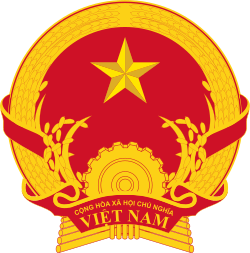



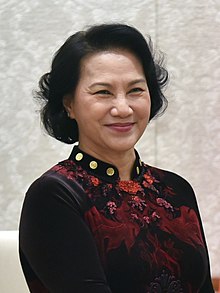


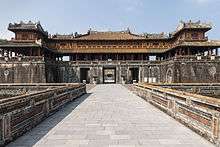

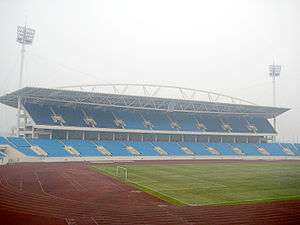

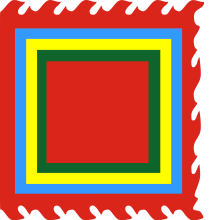
.svg.png)